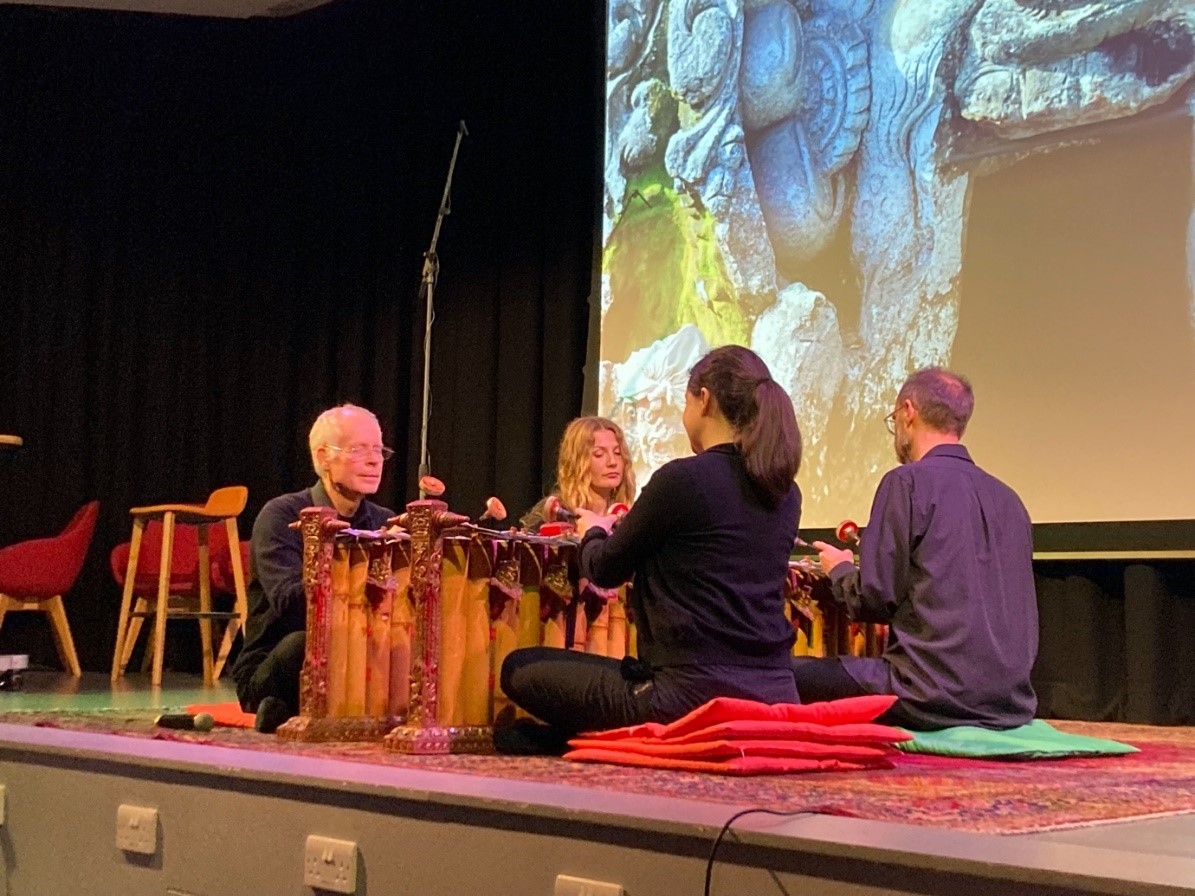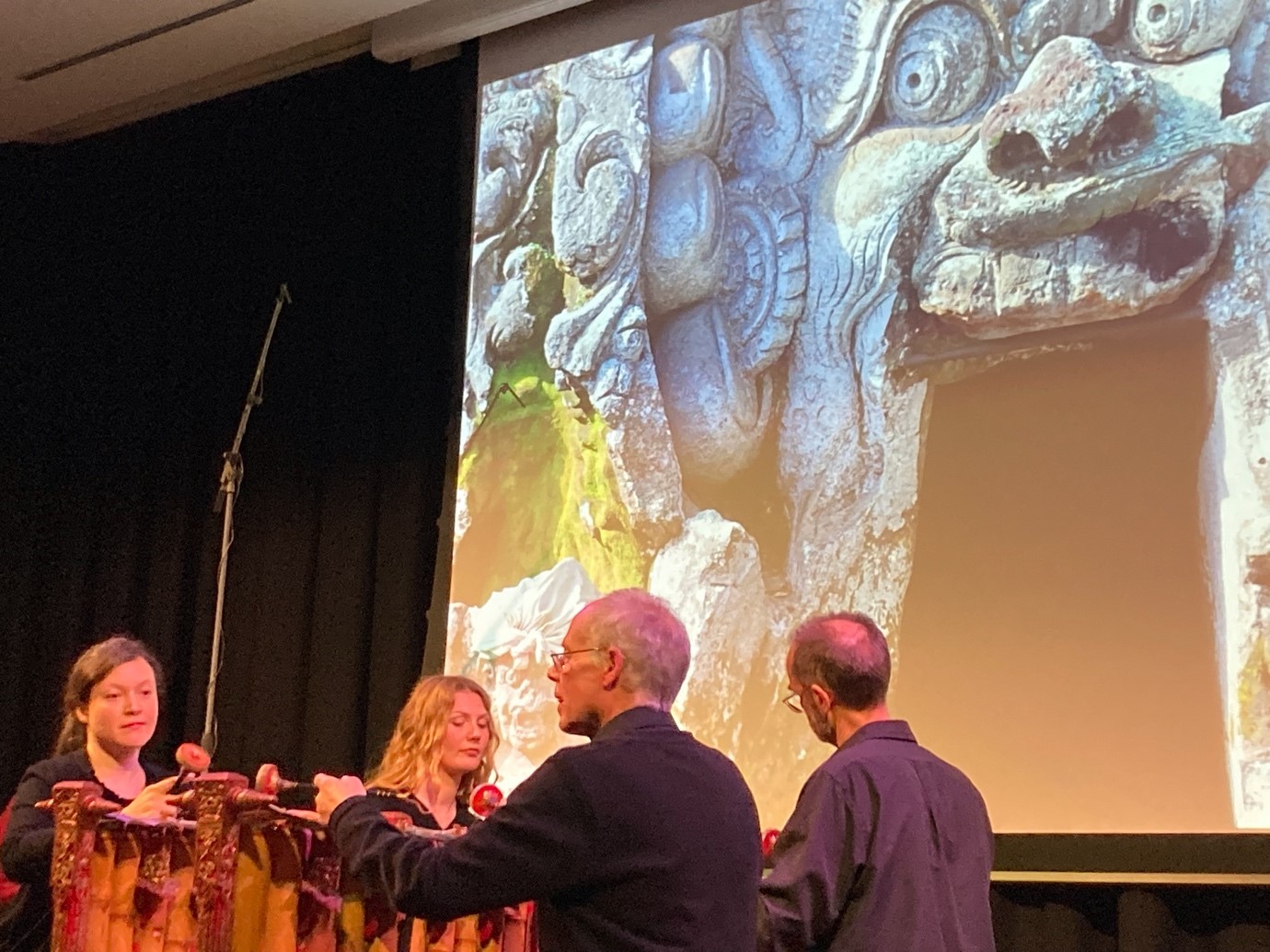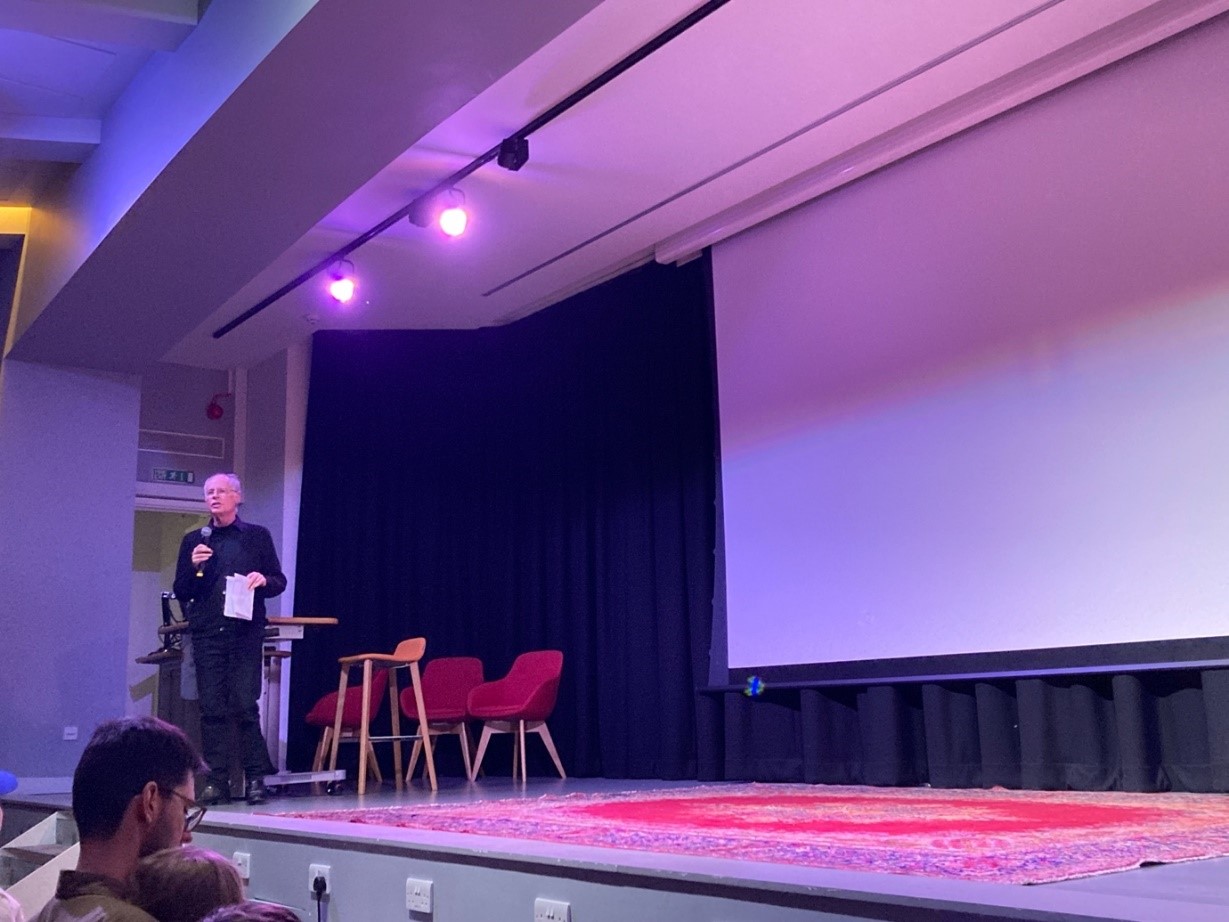2023 Activity Report
March Activity Report
22 March 2024
Global Japan Office Coordinator
Kazumi Taguchi
The subject of the March report from London is the Japan Research Centre (JRC) event which was organised by Dr. Satona Suzuki and Dr. Fabio Gygi. The event opened with an introduction to an exciting collaboration between SOAS and the Morohashi Museum of Modern Art which is located in Aizu, Fukushima, Japan.
The founder of the Morohashi Museum of Modern Art is Mr. Teizo Morohashi who started out in the clothing business and then expanded into the sports industry establishing the well-known sports brand Xebio.
The founder’s daughter, Ms. Hiroko Morohashi, who is the representative director of the United Sports Foundation and the Chairman of the Advisory Board of Xebio Holdings, gave a talk explaining how her father collected Modern European Art and then went on to build an art museum in his home prefecture of Fukushima.
Ms. Hiroko Morohashi said that her father always wanted to surprise people rather than please them. She remembered her father’s determination to build an art museum in order to give local people the opportunity to view masterpieces of Western Modern Art.
The second speaker was an artist whose works were acquired and are exhibited at the Morohashi Museum of Modern Art. A large number of her paintings have been purchased by the Museum.
The third speaker was an academic, Dr. Monica Hinkel who specialises in woodblock paintings. Dr. Hinkel spoke about how AI can play a part in developing and contributing to academic work.
There was a Minyo performance during the talks and at the reception after the talk featuring the singer, Akari Mochizuki and a Tsugaru Shamisen player (I am sorry, unfortunately I wasn’t able to ascertain his name)
After the talk, we all moved to foyer where an amazing Sushi and Sake tasting event was awaiting the audience.
It was a very relaxed and informal event and I thoroughly enjoyed it. Another hit event for the JRC!
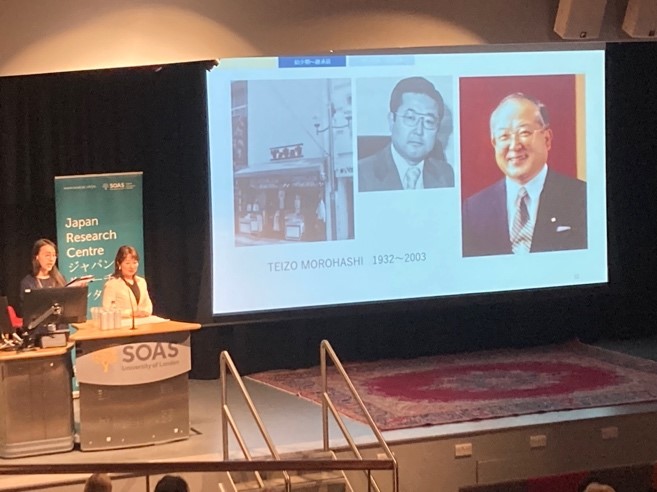
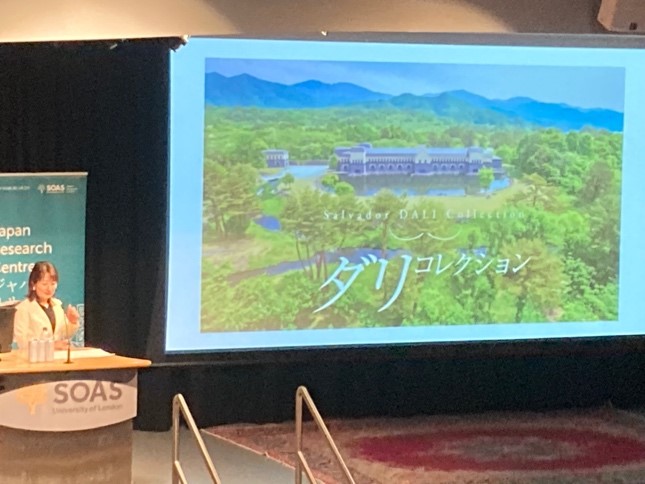
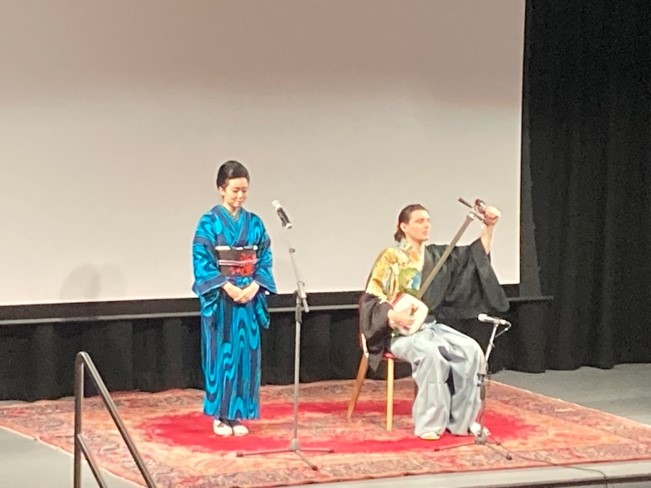
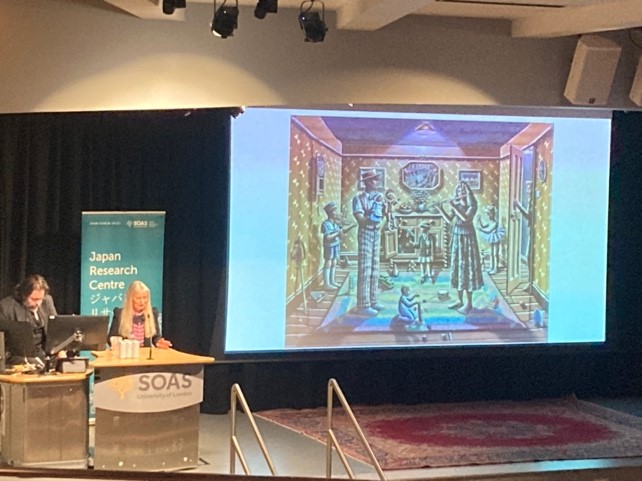
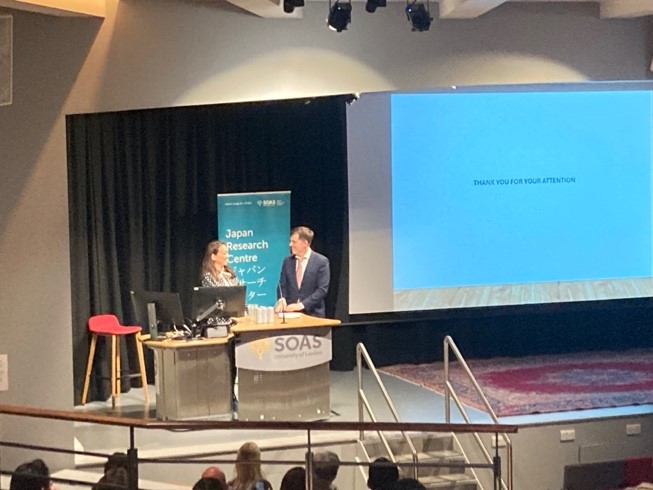

February Activity Report
29 February 2024
Global Japan Office Coordinator
Kazumi Taguchi
I would like to begin my February report writing about an interesting place I visited in Japan and which I wasn’t able to cover in my January report.
I visited a building which contained a giant wooden statue of Mary (about 10 metres tall) created by the artist, Eiji Oyamatsu from Fujisawa. It took over forty years to complete and was donated to the Minami-Shimabara region to appease the spirits of victims who died in the Shimabara-uprising which took place from 1637 to 1638 in Hara Castle in the Minami-Shimabara region.
Minami-Shimabara along with the Amakusa was a Christian stronghold. Many local Lords became Christians and promoted Christianity amongst the local population.
at the time of persecution of Christians ordered by the Tokugawa Shogunate. The novel is called ‘The Silence” and was later made into a film.
I was lucky enough to see this huge statue of Mary. It really is quite amazing that a sculptor spent forty years carving this statue in commemoration of the Christians who died for their beliefs.
My second topic is a talk I attended at the Daiwa Foundation in London. The talk was given by an Oxford University research student, Joel Littler. His research topic was the revolutionary, Naniwabushi balladeer, Miyazaki Tôten who was active in the Meiji period.
I came to know about his name and his career as a revolutionary and Naniwabushi chanter when I was researching Sôseki’s Chinese poems. The connecting point between Sôseki and Tôten was Maeda Kagashi who was an activist in the Freedom and People’s Rights movement, and who also served as a politician in the upper house of the Japanese parliament.
After retireding as a politician, Maeda Kagashi lived in his hometown, Oama in Kumamoto and offered up his annex and hot spring as a cultural salon where all kinds of intellectuals could gather and exchange ideas.
Sôseki worked in the Fifth High School in Kumamoto and visited Maeda family’s hot spring several times. He wrote a novel based on his experience in Oama, and the novel is called “Kusamakura”.
Miyazaki Tôten was married to the third daughter of Maeda Kagashi, Tsuchiko and she helped Tôten in his revolutionary activities.
Joel Littler gave a fascinating talk and I would thoroughly recommend reading his article in Modern Asian Studies published by Cambridge Press.
The third topic in this report is about a Chinese New Year Concert organised by SOAS student union. The main artists were Cheng Yu (Pipa and Guqin virtuoso) and Beibei Wang (percussion virtuoso).
Cheng Yu played along with a Qin group and Chinese Music ensemble whereas Beibei was accompanied by 2 piece and 4-piece Chinese percussion ensembles. I am sorry I missed taking photos of Beibei but I was so involved in her performance I completely forgot!
I was mesmerised by this amazing musical display performed by highly skilled musicians. And I am extremely pleased that SOAS student union was so active in promoting such high-quality music.
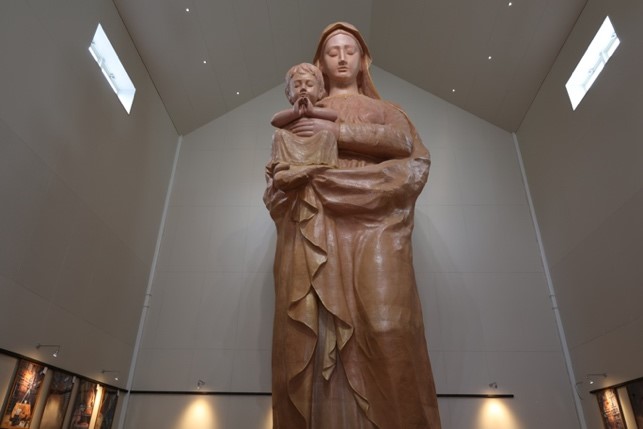
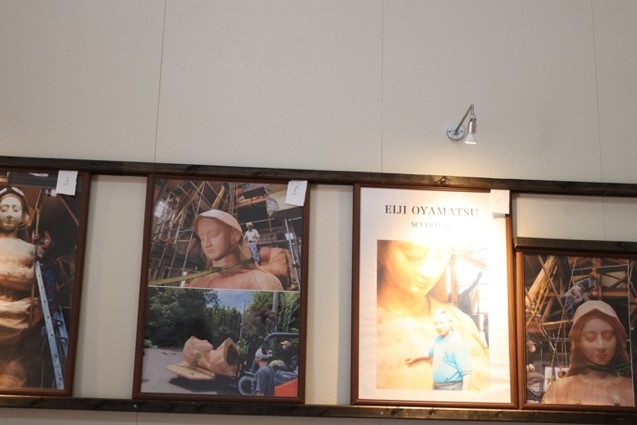


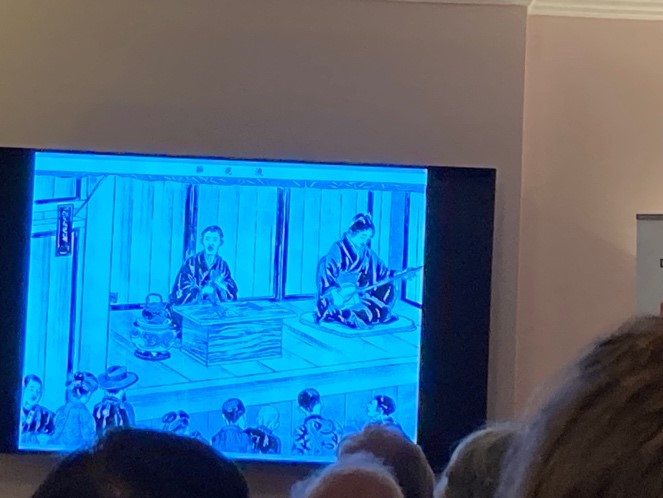



January Activity Report
31 January 2024
Global Japan Office Coordinator
Kazumi Taguchi
A Happy New Year!
I am back after seven weeks in Japan where I was shooting at various locations for my post doc project, my second series of poetic videos featuring Soseki Natsume’s Chinese poems.
So, this is the GJO London coordinator’s ‘visiting her homeland’ (Satogaeri) report.
One of the places I visited was Kumamoto where Soseki stayed for about five years before being sent off to London for two years by the Japanese Government.
In my first series of poetic videos I featured Nakoi hotspring where Soseki stayed to have a break from teaching and this time round I went to visit the Fifth High School in Kumamoto City. The Fifth High School is now called Kumamoto University and they have kept the old building in immaculate condition, as you can see in my photo.
Next, I went to Nagasaki where Soseki left for London as Nagasaki used to be the port to enter and depart the country for international passengers. One of the photos below is of Gunkan-jima, a mining island which at one time had an entire mining community with housing, schools, a hospital, and a shopping centre. Although there was no Gunkan-jima when Soseki departed from Nagasaki this remarkable island shows the importance of the shipping industry and the vital role it played in carrying passengers and goods for trade during the modernisation period in Japan.
After Nagasaki, I visited Fukuoka to watch Sumo which is nothing to do with Soseki’s Chinese poems, but I am a big fan of Sumo. I was surprised so many keen westerners devoted to the sport attended and they all seemed to enjoy the tournament as much as I did.
Then, I headed to Matsuyama in Shikoku via Hiroshima. Matsuyama is the birthplace of Soseki’s best friend, Shiki, and the famous novelist and poet moved there after leaving his home-town Tokyo to teach English. After a one year stay in Matsuyama, Soseki headed to Kumamoto for another teaching job. Soseki’s time in Matsuyama became the inspiration for one of his early novels Bochan. He was very fond of visiting the Dogo Onsen (hot spring) when he lived in Matsuyama.
I also travelled to Kyoto to visit the Zen temples. I went to the Arashiyama district and fell in love with its wonderful scenery of beautifully landscaped gardens and hills. The photo is a view from Togetsu-kyo (Togetsu bridge) which Soseki loved. He loved the simplicity of nature and it gave him special spiritual comfort especially when he was ill.
After leaving Kyoto, I went to Hakone to visit a Ubako hot spring where Soseki went to heal his eyes when he was a university student. The place is not a commercial hot spring, and it has a history of being a spiritual place for mountain ascetics. The public bath had a huge sacred rope placed in front of a natural rock surface, and I felt the power of nature while taking a bath and looking at the huge rocks hanging in front of me.
I visited Enkakuji temple in Kamakura and found another hut where Soseki practiced Zazen (Zen meditation method). I was really pleased to find this new location. The temple offers practice in meditation both in person and on zoom for people who are interested in quiet meditation.
Soseki also visited Chiba for a swimming holiday when he was a youth and later went to a hot spring in the region as well. Boso peninsula is famous for its numerous beaches and I went to a spot which Soseki visited and which became the birthplace of sea bathing in Japan.
Of course we cannot forget Tokyo, Soseki’s birthplace and where he lived after his return from London. I went to his memorial museum in Shinjuku where I was able to see his study as reconstructed by the museum. Soseki used to hold regular Thursday meetings at his house for his students where they discussed all kinds of interesting subjects, exchanged information and sought advice from Soseki.
In order to further my understanding of Soseki as one of the important individuals who established Japan’s modern literature of today, I visited Kanagawa Contemporary Literary Museum. It is situated in a lovely location looking down on Yokohama harbour. And I was lucky enough to see a small exhibition there which contained a brush and ink painting Soseki created to accompany a Chinese poem composition.
Just before I left Japan for London, I managed to squeeze in a one day stop in Shuzenji in Izu where Soseki recuperated from his stomach ulcer. Shuzenji is situated deep in the mountains and is a perfect location to escape from city life. I can understand the reason Soseki chose to come to Shuzenji to get away from working hard in the city and in order to recover from his illness in a quiet and tranquil environment.
Well, that’s all from my January London report which was all about my journey to Japan in November and December.
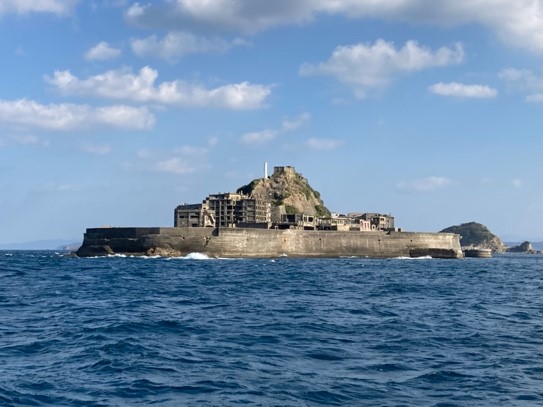
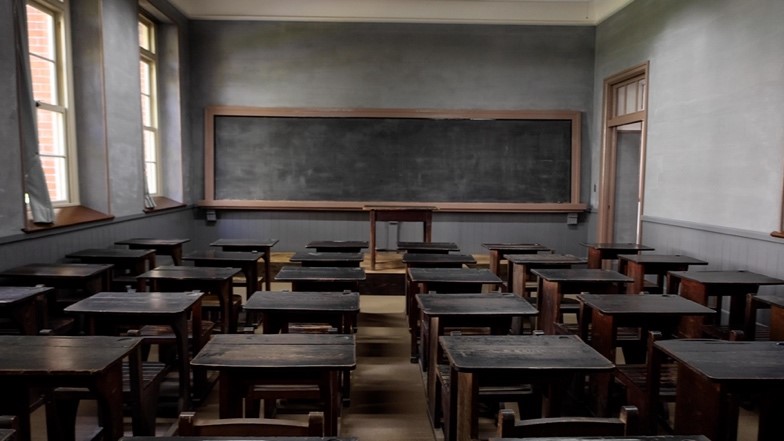
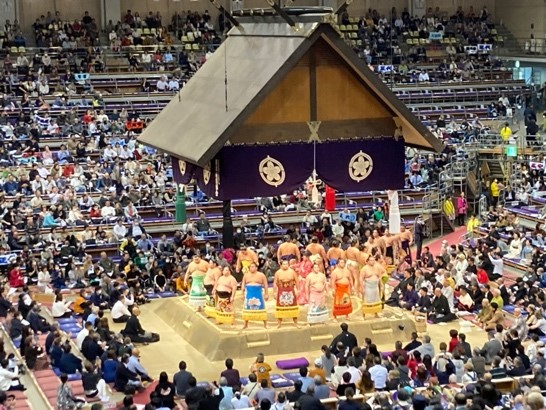




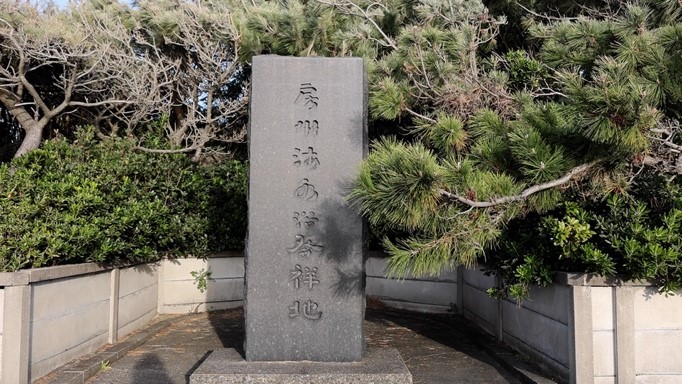
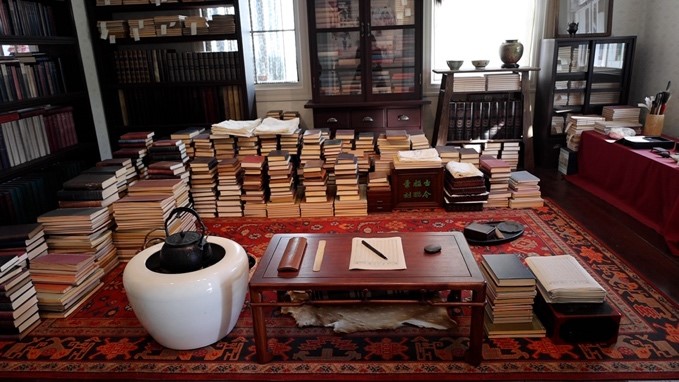


October Activity Report
31October 2023
Global Japan Office Coordinator
Kazumi Taguchi
The current London report is about Japan Matsuri 2023 which took place at Trafalgar Square at the beginning of October.
It is a free annual festival which aims to give the people of London an authentic experience of Japanese culture.
There were many performances including the London Taiko Drummers, Radio Taiso, a Kendo demonstration, the London International Concert Orchestra, an Ohayashi couple, an Aikido demonstration, Minyo songs performed by the SOAS Minyo group, Okinawan music performed by the London Okinawa Sanshinkai, Yosakoi dance performed by the London Yosakoi dancers, Ainu songs by Ankes and much more.
There were also many Japanese food stalls which were extremely popular as all the food bars had a long queue of eager customers.
It wasn’t that sunny a day but was still very pleasant and a great many people came along to experience Japanese culture for a day.
I took part in the event as a member of the SOAS Minyo group. We performed “Tawaratsumi-uta”, “Sakaya-uta”, “Aizu Bandaisan”, and “Tanko-bushi”. The SOAS Minyo group also participated in the Awaodori performance playing Shamisen and Kakegoe as a part of the backing for the Awaodori dancers.
October is also the beginning of the academic year. Students are back in campus and ready to start an exciting new phase in their life in London!
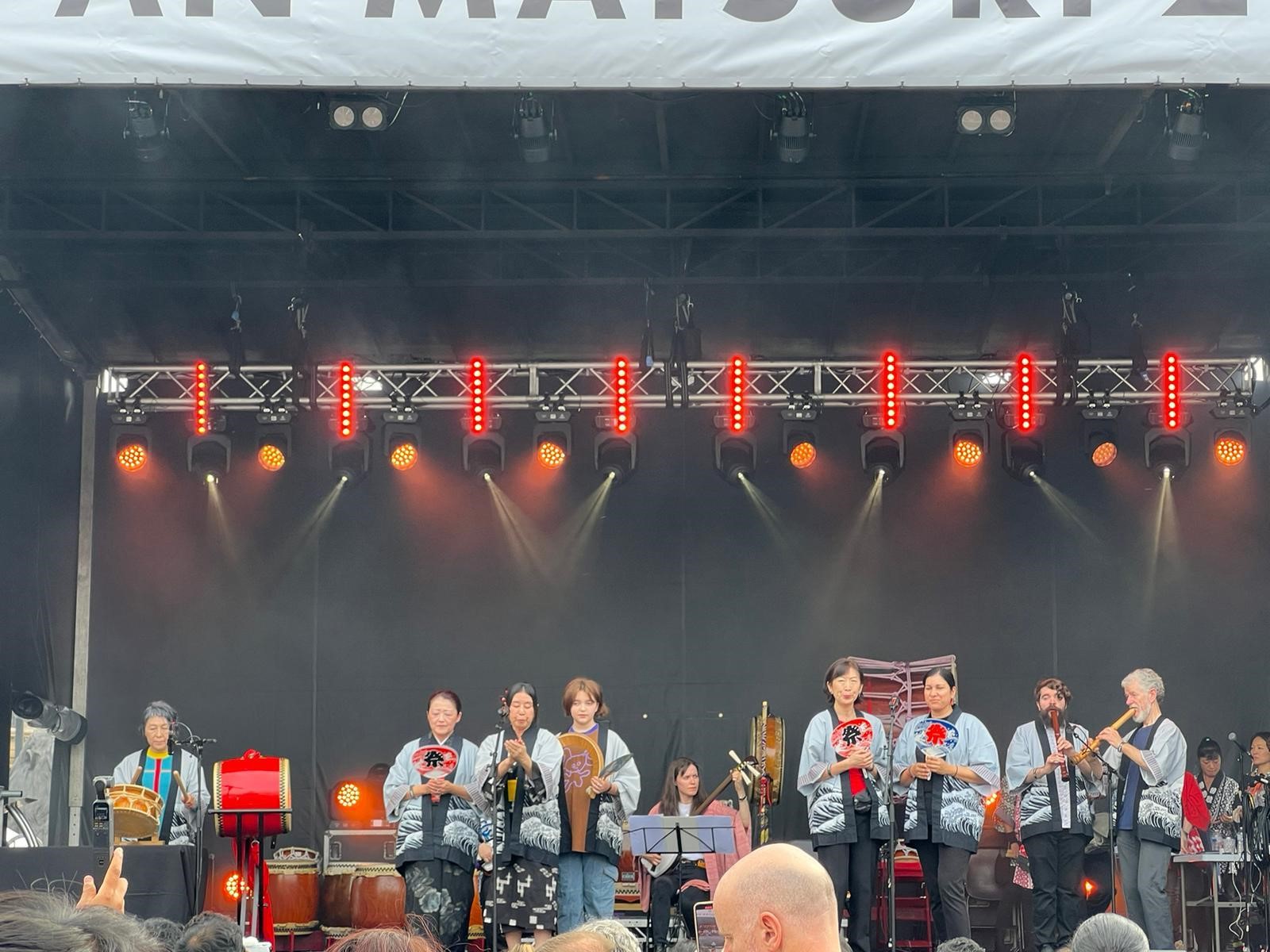
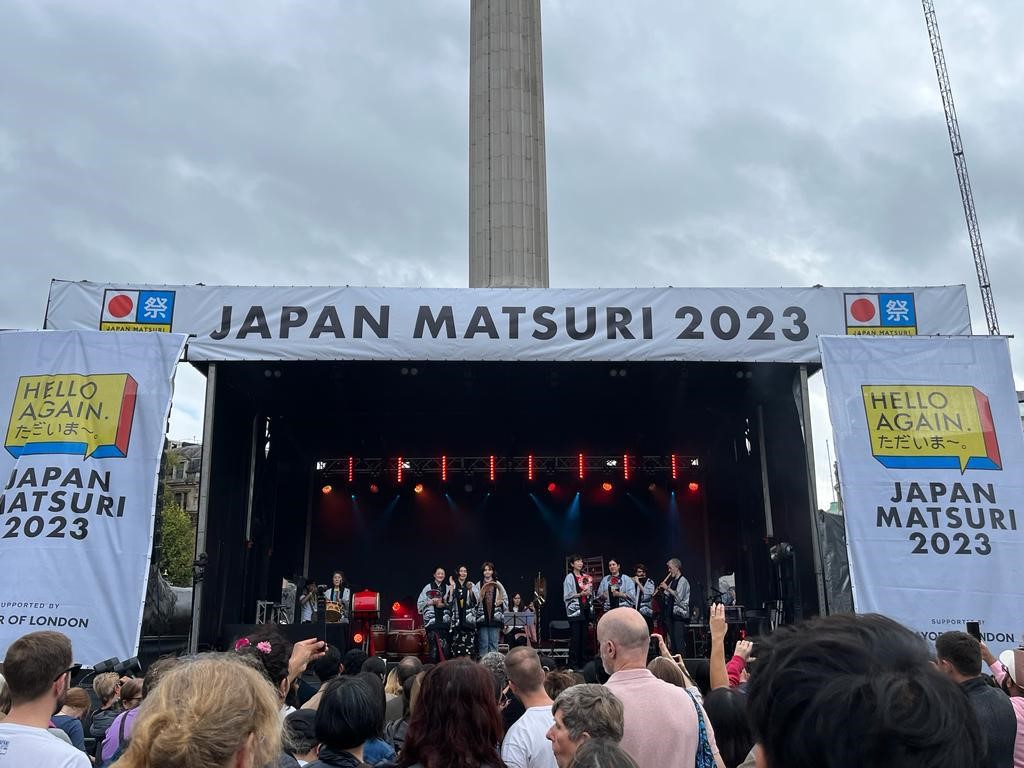


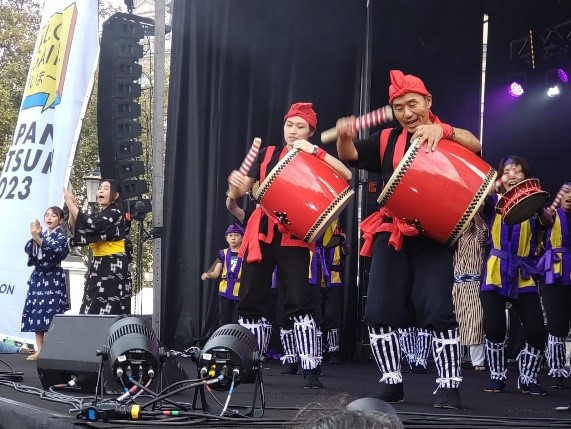
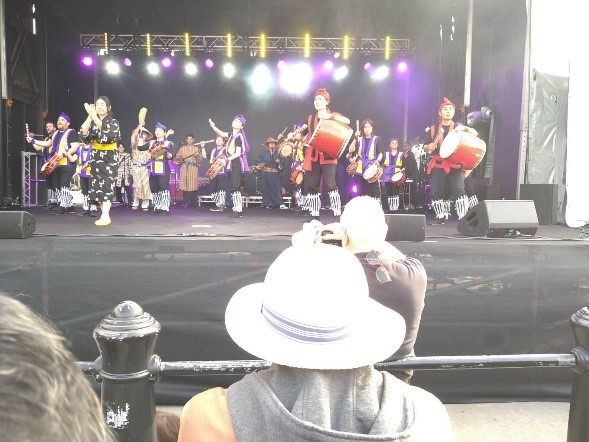
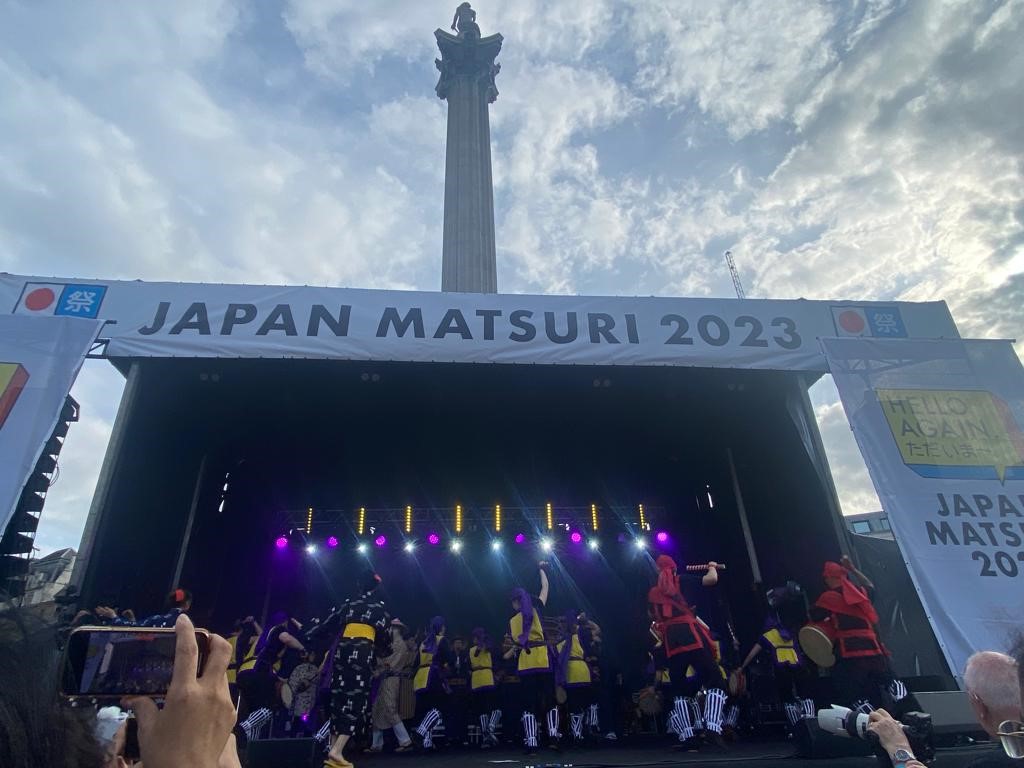
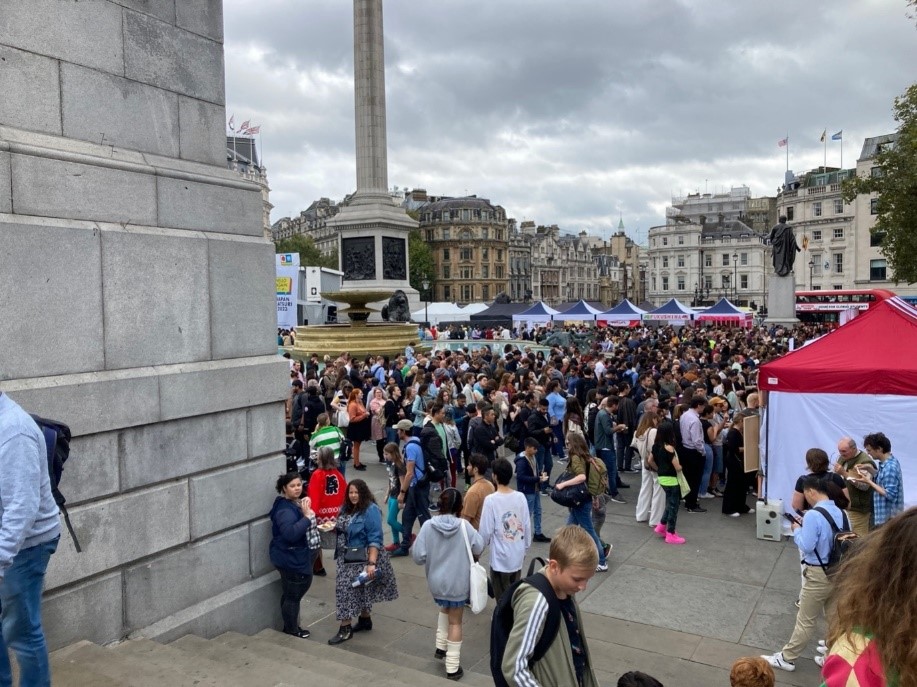
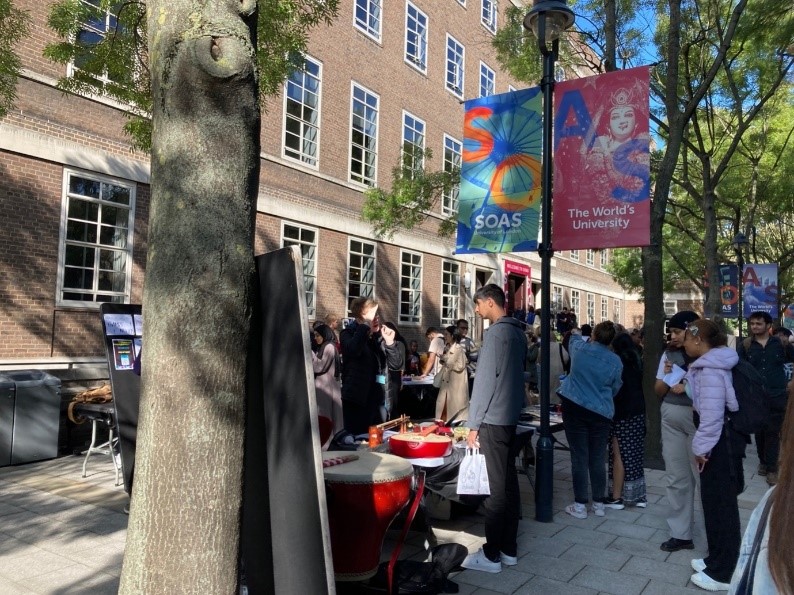
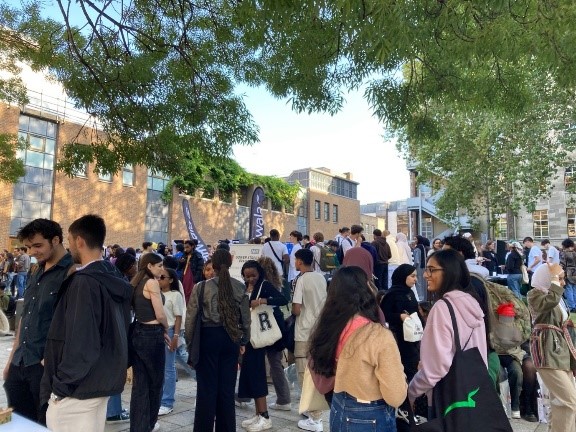
September Activity Report
30 September 2023
Global Japan Office Coordinator
Kazumi Taguchi
The September London report concerns a talk event held at Japan House which is a Japanese cultural centre with shop and restaurant, and the occasion was the celebration of the 5th anniversary of their opening in 2018.
The talk was titled “Revisiting Sumidagawa” and featured a conversation with Sano Noboru and Dr. Cummings.
Some readers may know who Sano Noboru sensei is as I wrote about his Noh performance in London in June 2022 in my June 2022 report. Let me explain a little about Sano sensei. He is a Hosho School Noh leading actor and as well as performing Noh teaches Noh inside and outside Japan.
Sano sensei was trained as a Noh performer from a young age and he has spent a long time as a leading actor (Shite) in the Hosho school of Noh. Besides performing as a Noh actor/dancer, Sano sensei is extremely enthusiastic about introducing and teaching Noh to all types of people and all age groups.
After last year’s achievement in performing and holding workshops at King’s Place, London, Sano sensei is back in the UK this autumn to give talks and workshops in London, Sheffield and Birmingham.
Before Sano sensei set off to Sheffield, I had a chance to listen to his talk on a famous Noh play, “Sumida River”.
For people who don’t know the story, here’s a summary: a little boy called Umewakamaru gets kidnapped by a slave trader. After realising her son is missing, his mother begins her journey to find her son, leaving her home in the capital Kyoto and travelling to the eastern province where modern-day Tokyo is located. There is now a scene where she has to cross a river in order to find her son. She gets on a boat and the ferryman tells passengers a story of a poor boy called Umewakamaru who died a year ago today at Sumida River. He asks the passengers to participate in the first-year memorial ceremony for Umewakamaru’s death. The mother now realises that it was her son who died at the river. Emotionally overwhelmed the mother can’t stop crying on discovering she has lost her son. The ferryman asks why she is crying, and the mother tells him Umewakamaru is her son. The ferryman takes the mother to Umewakamaru’s burial mound and ask the mother to chant Buddhist prayers to mourn Umewakamaru’s soul.
While she recites a Buddhist chant, Namuamidabutsu, a ghost of Umewakamaru appears in front of the mother during the night. The mother tries to hug her son, but it proves to be in vain which makes her even more sad. At dawn, the ghost of Umewakamaru disappears and the mother looks towards sunrise.
Sano sensei explains that he thought “Sumida River” is just a sad story until he had a chance to play the role of the mother. He explains he found out that this play expresses more than sadness. It shows that there is an enlightenment after going through extreme sadness. It makes you realise that human beings are part of nature. After coming to terms with her son’s death and encouraged by the unchanging eternal cycle of nature, she looks towards sunrise to show her determination to carry on living.
After a fascinating talk, there was a mini demonstration. Sano-sensei adopted the pose of the mother looking towards sunrise. His posture clearly showed her determination and strong will.
Sano-sensei also did a little workshop in which he sang sing a Buddhist chant, Namuamidabutsu, along to the rhythm of the beating of a small gong.
After the singing workshop, Sano-sensei showed how by moving the mask and looking down he was able to change the expression of the character.
Then, it was time for audience participation. A lady from the audience was given the chance to wear a mask and express the pose of crying.
Finally came the Q&A session. There were many interesting questions asked by the audience. One of the questions was how Sano-sensei prepares himself in order to play a character. Sano-sensei explained that there is a mirror room where you are able to see yourself and get ready and also explained how an actor bows at the mask when he puts it on and again when he takes it off.
It was a wonderfully informative and emotional talk given in a relaxed and informal manner. Now I can’t wait for Sano-sensei’s Noh performance and workshop in London next year.
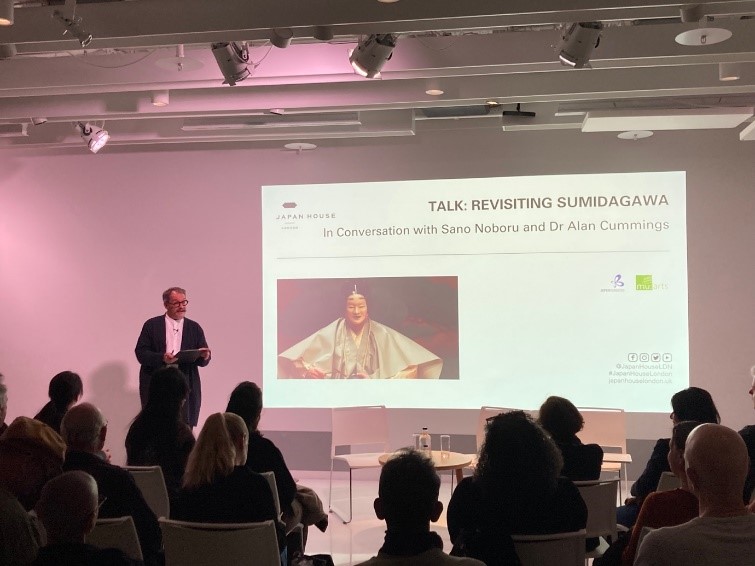
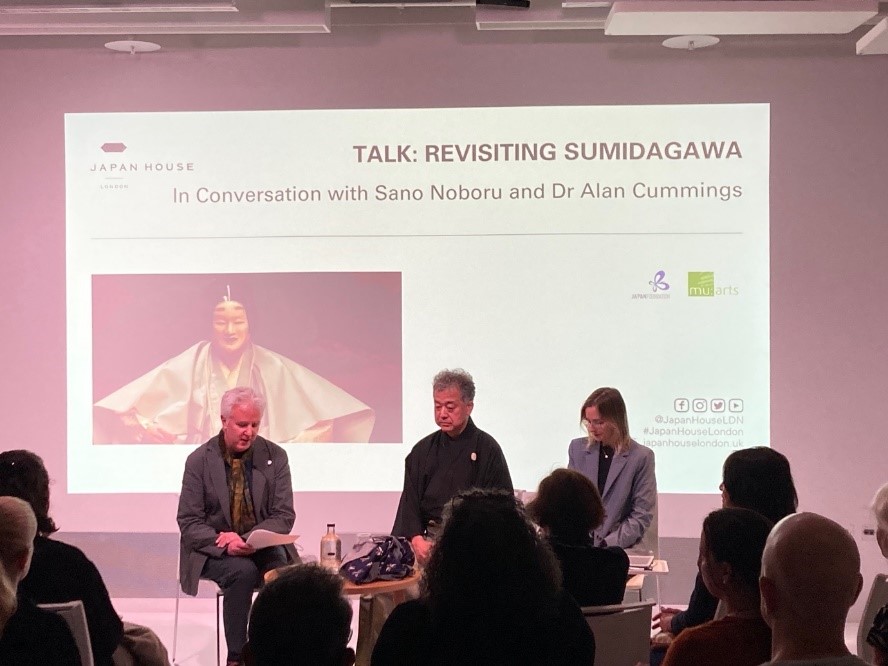
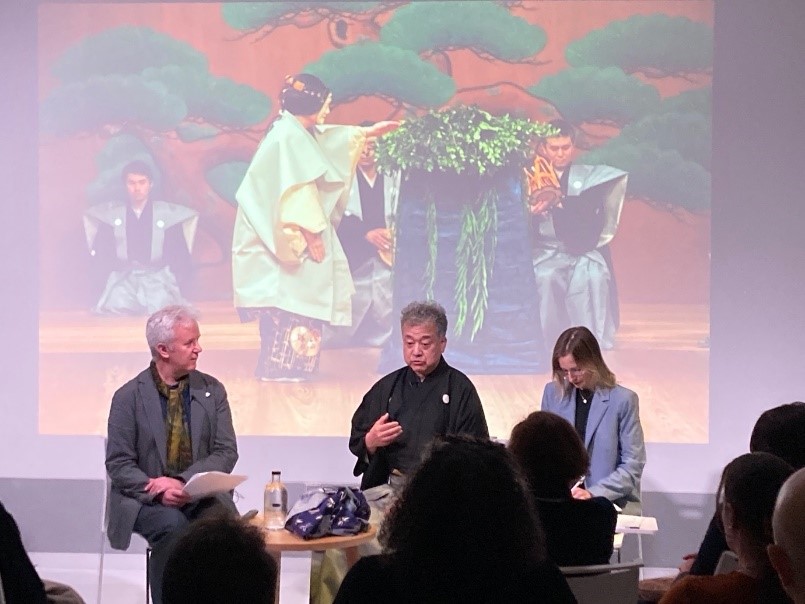

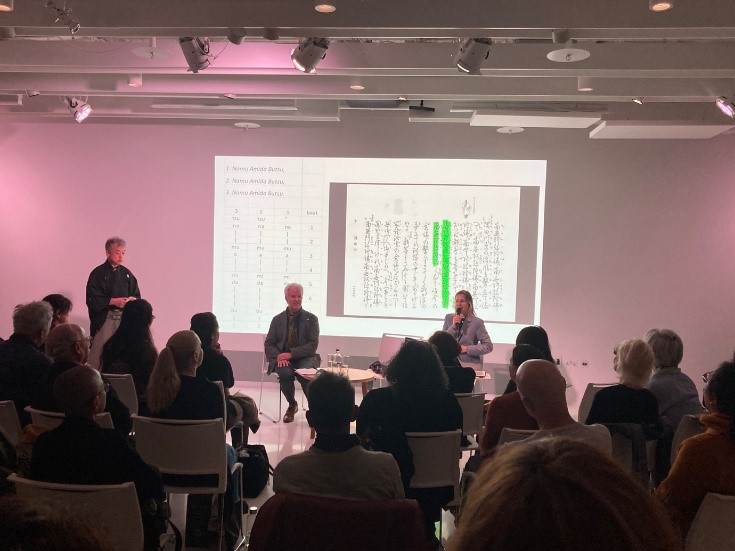


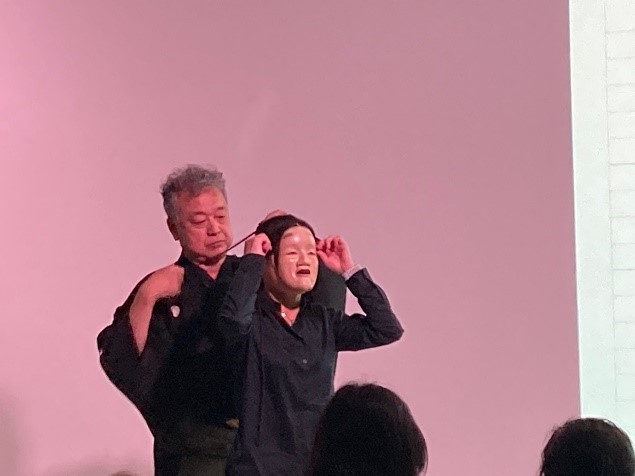
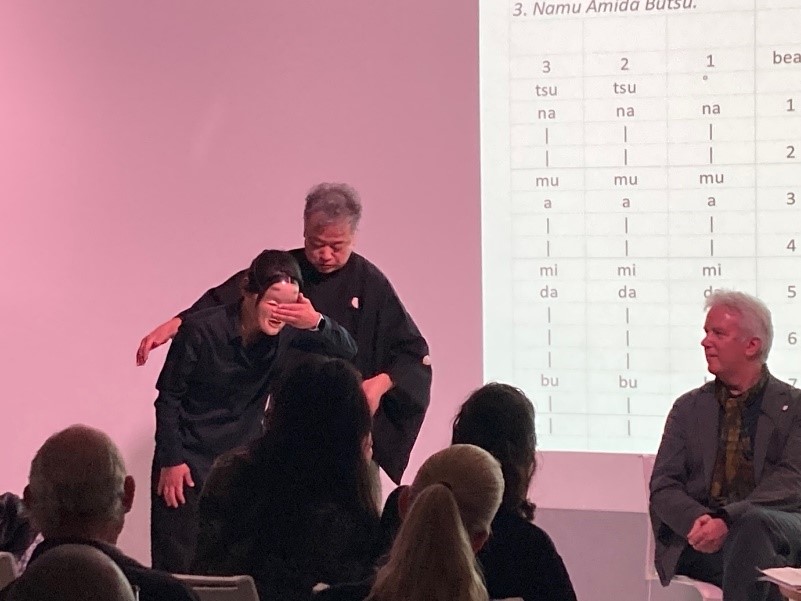

August Activity Report
31 August 2023
Global Japan Office Coordinator
Kazumi Taguchi
The August London report is about a garden picnic in Notting Hill in West London that I was invited to by my friend, Mariko who is an artist.
Many of the readers may have heard of Notting Hill, as it is the title of a popular film as well as the name of an area in West London. It also has a famous antique market which bring many people to the area. And the district also has a distinctive bohemian flavour.
My friend, Mariko has been living in this area for a very long time and has many friends who live round Notting Hill. They have been organising a private garden picnic around this time of year for many years. Mariko invited me to one of their private garden picnics and I would like to write about it as it is a quintessential part of British culture.
British people love horticulture, gardening, landscape and architecture. We have Chelsea Flower Show and Hampton Court Flower Show, and there are many competitions in the garden architecture world to design a themed private garden. People admire nature and love to go for walks or get close to nature in a garden, square or park.
The concept of the public park started in the 19th Century when the middle class emerged in this country. Since that period, people use public gardens, squares and parks for relaxation, fun and to just generally get in touch with nature.
The private garden where Mariko organised the garden picnic is owned by one of the city councils. This publicly owned private garden is one of the largest in London. Anybody who lives within 100 metres has the right to apply for the use of the garden on an annual basis by paying a fee to the council. Then, you can get a key which gives you access to a marvellous private space in Notting Hill.
In my impression, it is a little like “A Mid-Summer Night’s Dream”. You gather together in the late afternoon/early evening on a summer’s day and have a picnic. You are taken to another place surrounded by trees, plants and flowers, it is a very pleasant moment; lovely to be lost in nature and I highly recommend it.
The day we had the picnic. it was the birthday of one of Mariko’s friends. How nice it is to have your birthday party in a huge quiet garden with the rattling sounds of leaves all singing Happy Birthday to you. Life in London is not bad at all.

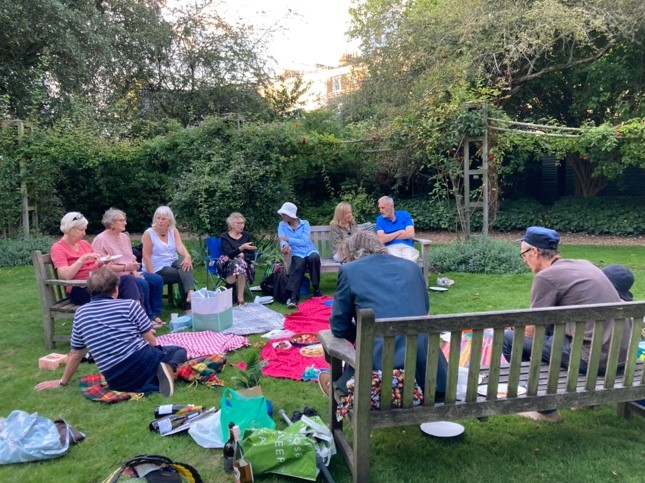
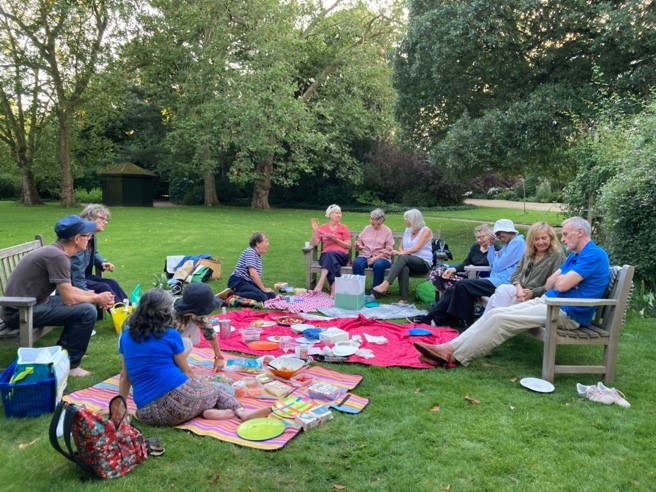
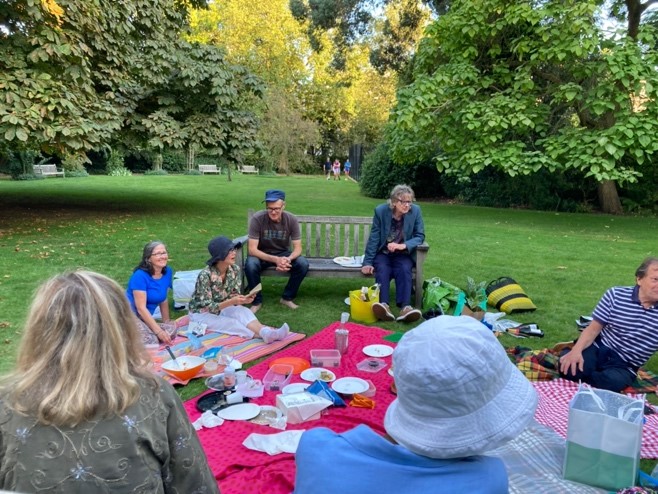
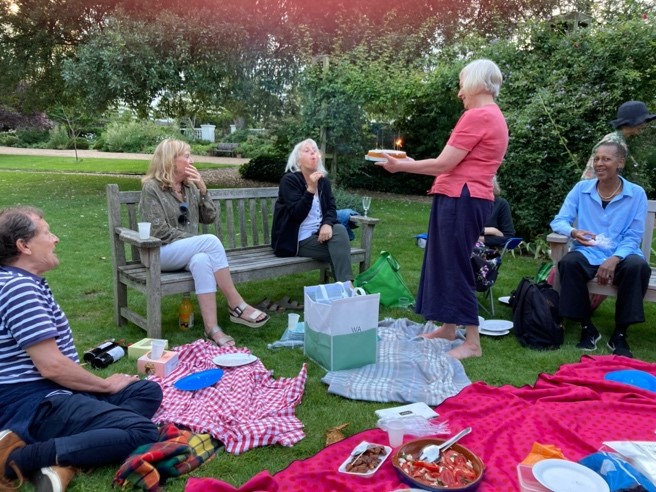
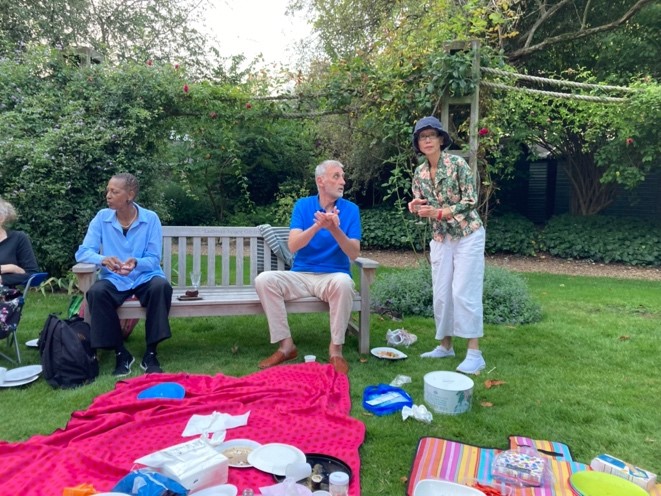
July Activity Report
31 July 2023
Global Japan Office Coordinator
Kazumi Taguchi
The July London report is about a Tsugaru-shamisen concert which I went to see in East London.
The headliner was Mitsune from Berlin. Mitsune consists of three Tsugaru-shamisen, a double bass and percussion. Two of the three Tsugaru-shamisen players have been taught by Hibiki Ichikawa, who I have featured many times in past reports. Hibiki is also a very important member of the SOAS Minyo group which was founded by Dr. David Hughes and has been run by him for many years now.
Hibiki Ichikawa is based in London and performs and teaches Tsugaru-shamisen. As well as playing in front of live audiences, he has performed on the soundtracks of a number of films (anime), collaborated with Japanese folk tale theatre and featured in a video for a major sports product company. Hibiki is also very passionate about teaching Tsugaru-shamisen outside Japan and very keen to nurture talented Tsugaru-shamisen musicians in the UK and Europe.
This concert was a great reflection of how Hibiki has managed to transmit his skill and passion for playing the Tsugaru-shamisen to musicians in Europe.
The night started with Hibiki’s youngest student, Alex who has been studying under Hibiki for nearly four years. She played two numbers, one with techno backing sound and the second a traditional tune. And she was just amazing.
Next, Hibiki and two of his most experienced students played as trio. Sometimes they played a pure Tsugaru-shamisen piece, other times the Tsugaru-shamisen, guitar and percussion. Enka and Minyo singer, Akari Mochizuki joined them later to sing some songs from the Minyo repertoire. By this time, I was well and truly into the groove of Minyo music.
After the Hibiki trio, the headliners, Mitsune appeared, all wearing oriental theme costumes similar to an opera production of Mikado. They were very theatrical in appearance and played Minyo in Mitsune style and their magnificent performance also featured a strong element of free jazz.
The audience was lively and involved. There was a fabulously energetic atmosphere in the venue and the time went by very quickly indeed.
It was lovely to witness Japanese culture combining with other cultures and in the process managing to remain traditional while at the same time transforming the form and creating something very original and exciting.
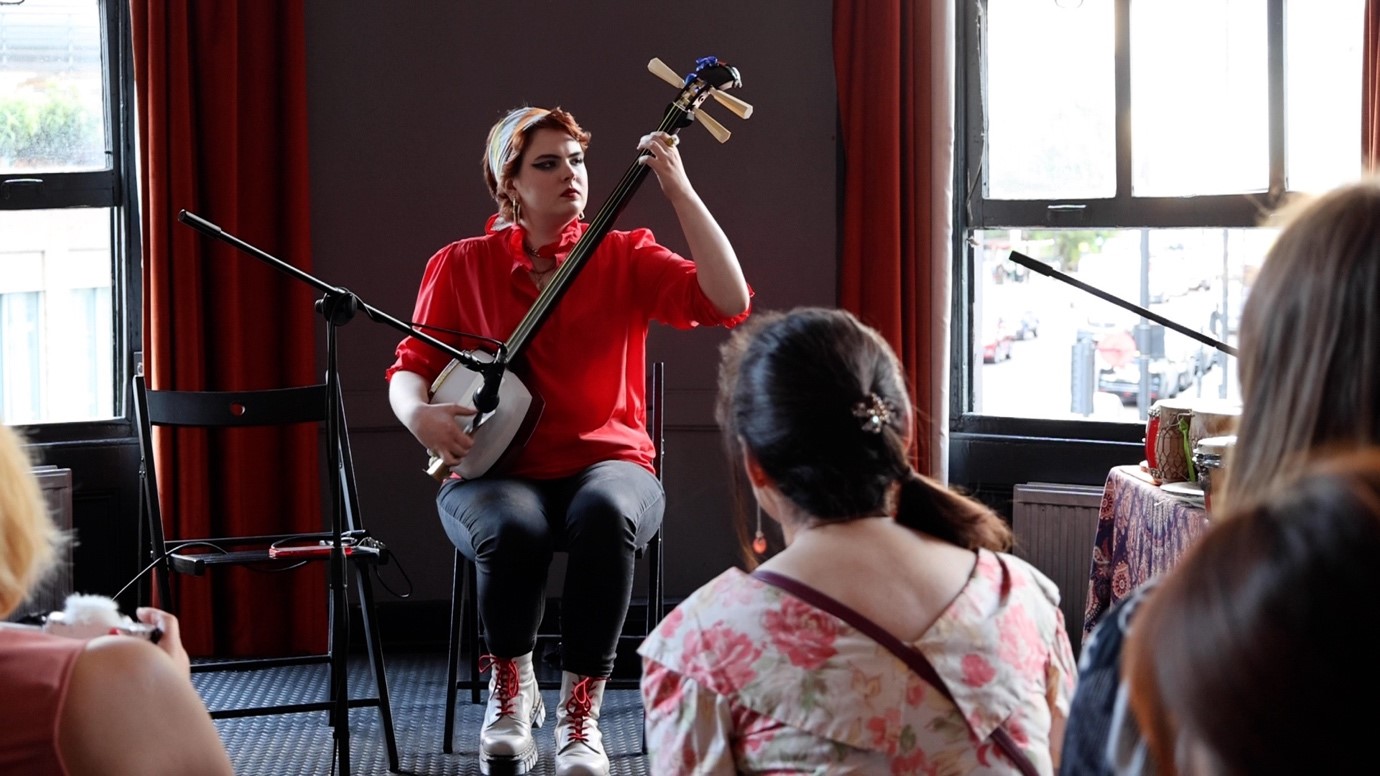

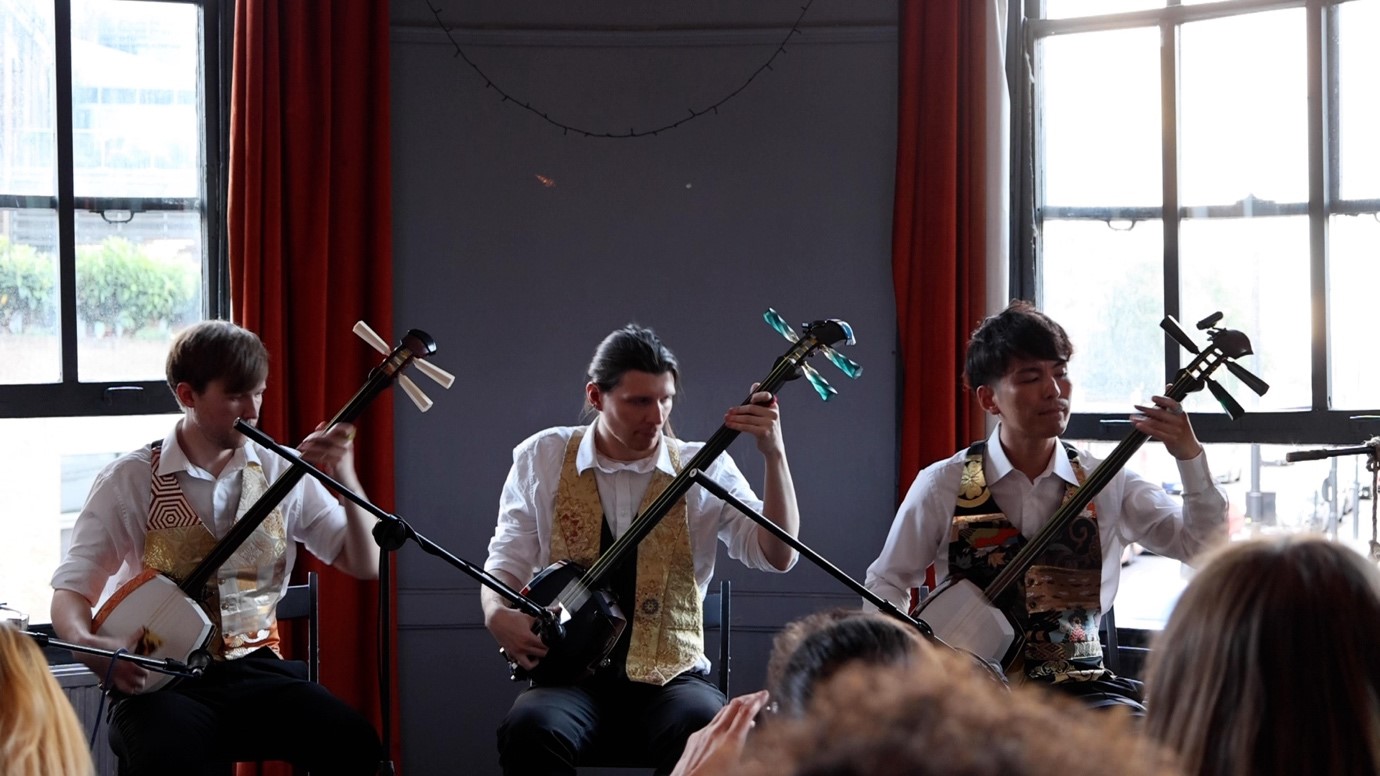
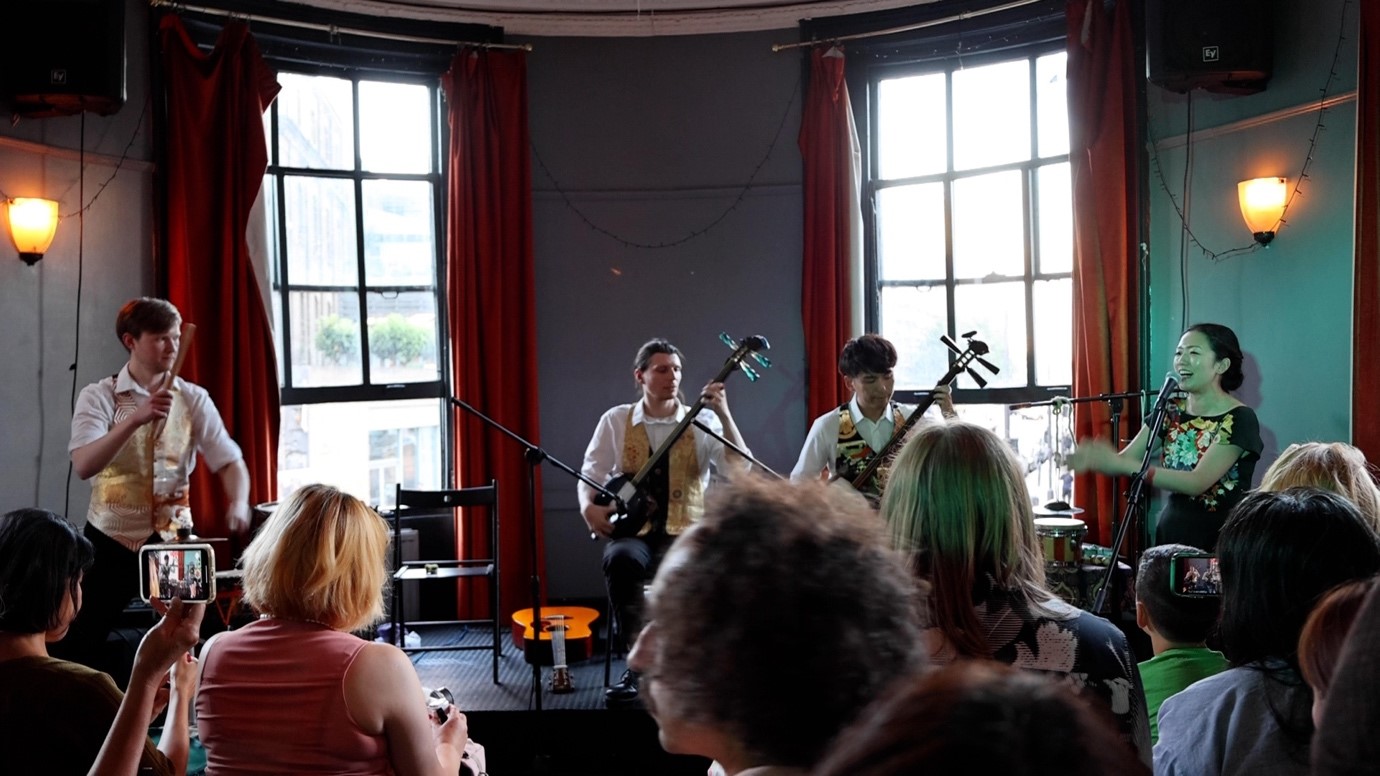

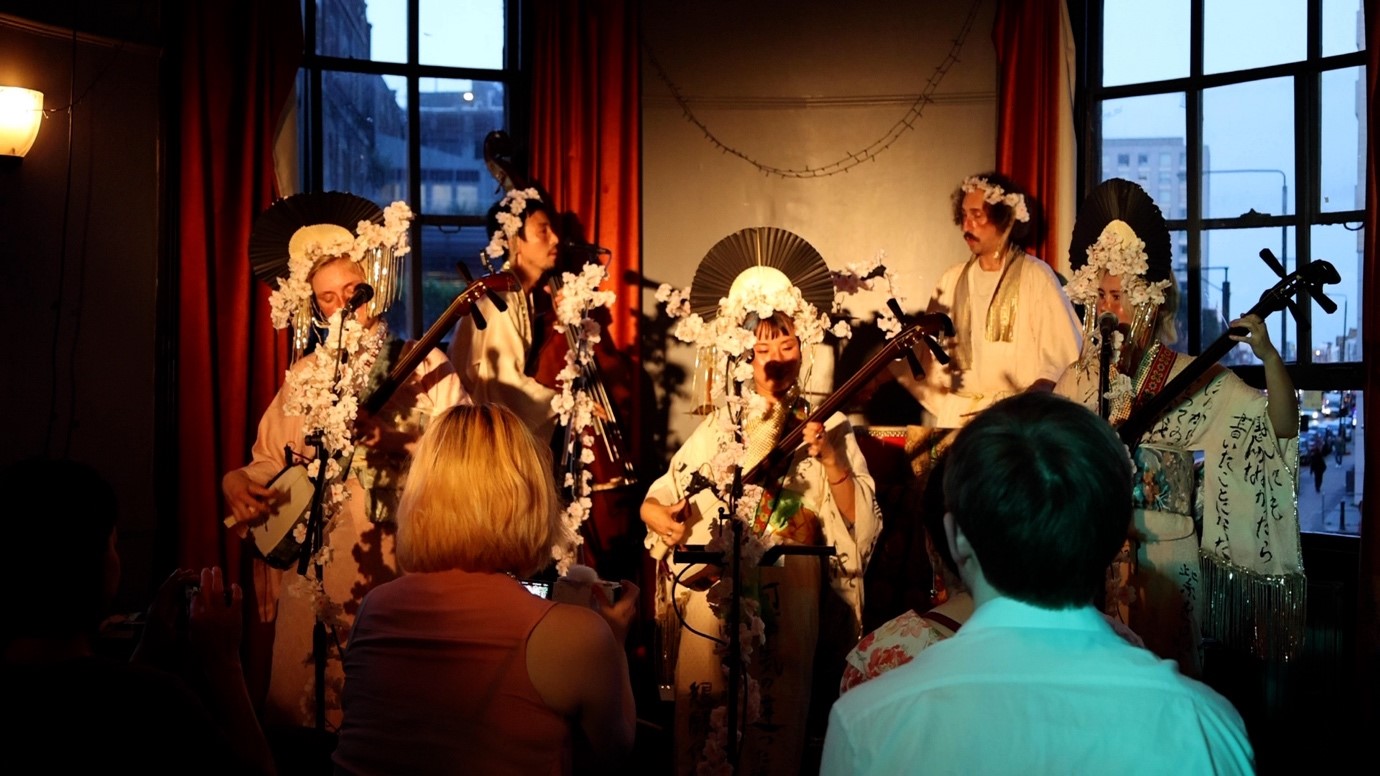
June Activity Report
30 June 2023
Global Japan Office Coordinator
Kazumi Taguchi
I would like to write about an event called SOAS SIZHU ENSEMBLE AND FRIENDS (A Concert of Chinese, Japanese, & Chinese-Peruvian Music) which was held at the Brunei Gallery at SOAS.
The event was organised by Dr. Hwee San Tan who has a PhD in Music from SOAS. Dr. Tan led the SOAS Sizhu Ensemble which performed two pieces of Shanghai Teahouse Music. The musical instruments played by them on the night were the Dizi, Erhu, Zhonghu, Sanxian, Zhongruan, Xiaoruan, Sheng, drums and Guzheng. The atmosphere was such that the audience was made to feel as if they were listening to music in a tea house in China.
The second act was a solo drum performance by SOAS student Jaydee Cozzi. She performed two pieces which were extremely powerful and moving. This was followed by folk songs from Okinawa performed by the London Okinawa Sanshinkai. They performed 3 Okinawan folk songs which included a delightful dance, and which created a relaxing and exciting atmosphere.
The fourth act featured a duet of contemporary Chinese music with Chinese bamboo flute and violin. It was a very intense and fascinating mixture of music. Next, we had Chinese folk tunes & puppets performed by the SOAS Sizhu Ensemble & Peruvian artist Jose Navarro. The puppet manipulated by the Peruvian artist was a similar size to a Bunraku puppet. The only difference was that a Peruvian puppet is manipulated by strings and only has one puppet master.
The sixth performance was of folk songs from Japan by the SOAS Minyo Group. They entertained us with folk songs from various parts of Japan including an Ainu people’s song from Hokkaido. They sang traditional folk songs which were originally related to work activities, such as a rice polishing song and a cow chasing song. It was a thoroughly amusing and entertaining show.
Then, we had excerpts from Chinese Opera sung by a Chinese Opera singer based in Denmark. He performed two styles of opera, one from the Beijing Opera and the other from the Kunqu Opera. And it was a truly fascinating performance. Last but not least was a thrilling ensemble piece of a Peruvian folk tune. And it was a brilliant way to end a lovely cultural event which was not only informal and friendly but also incredibly rich in content.
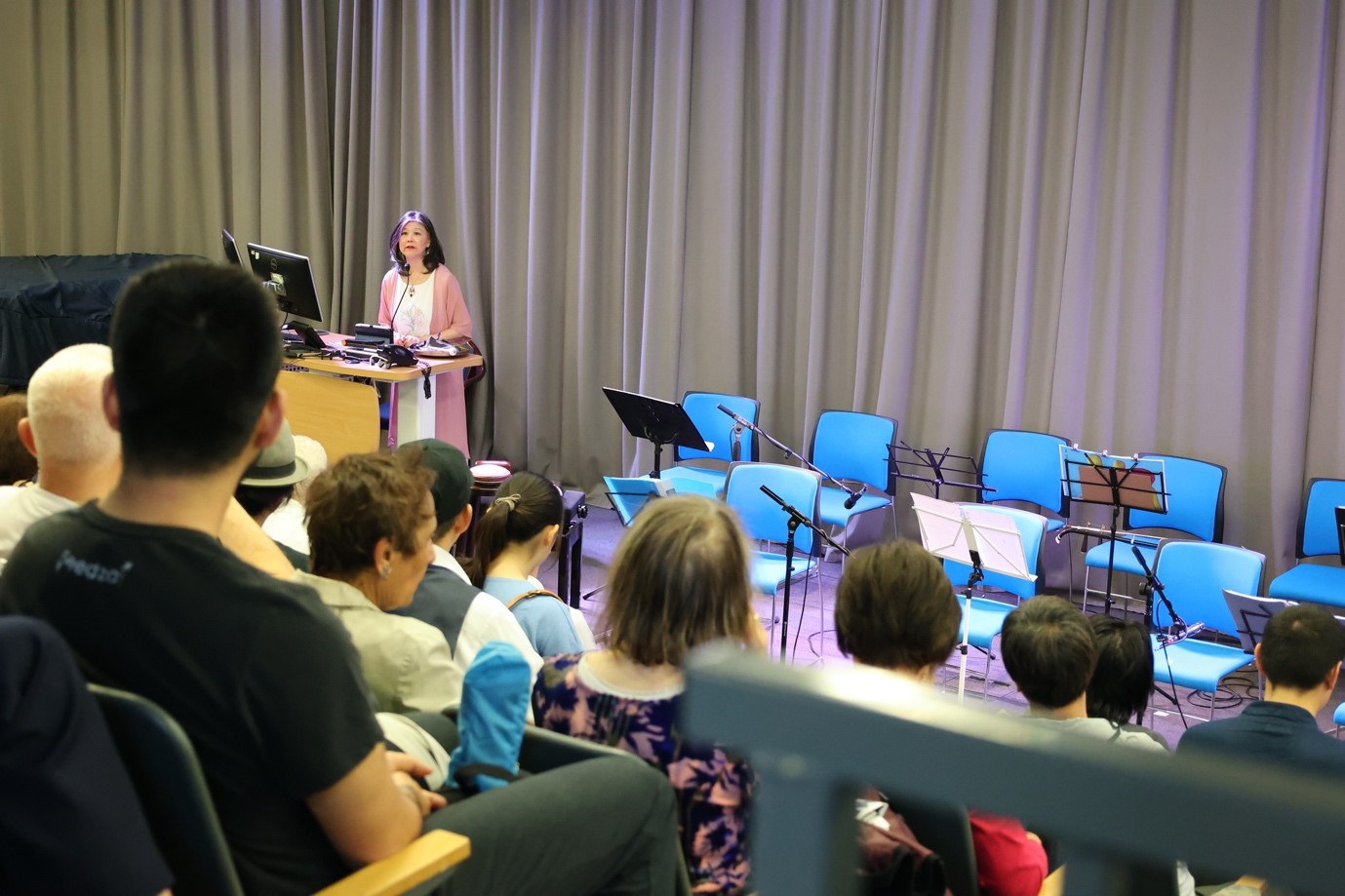
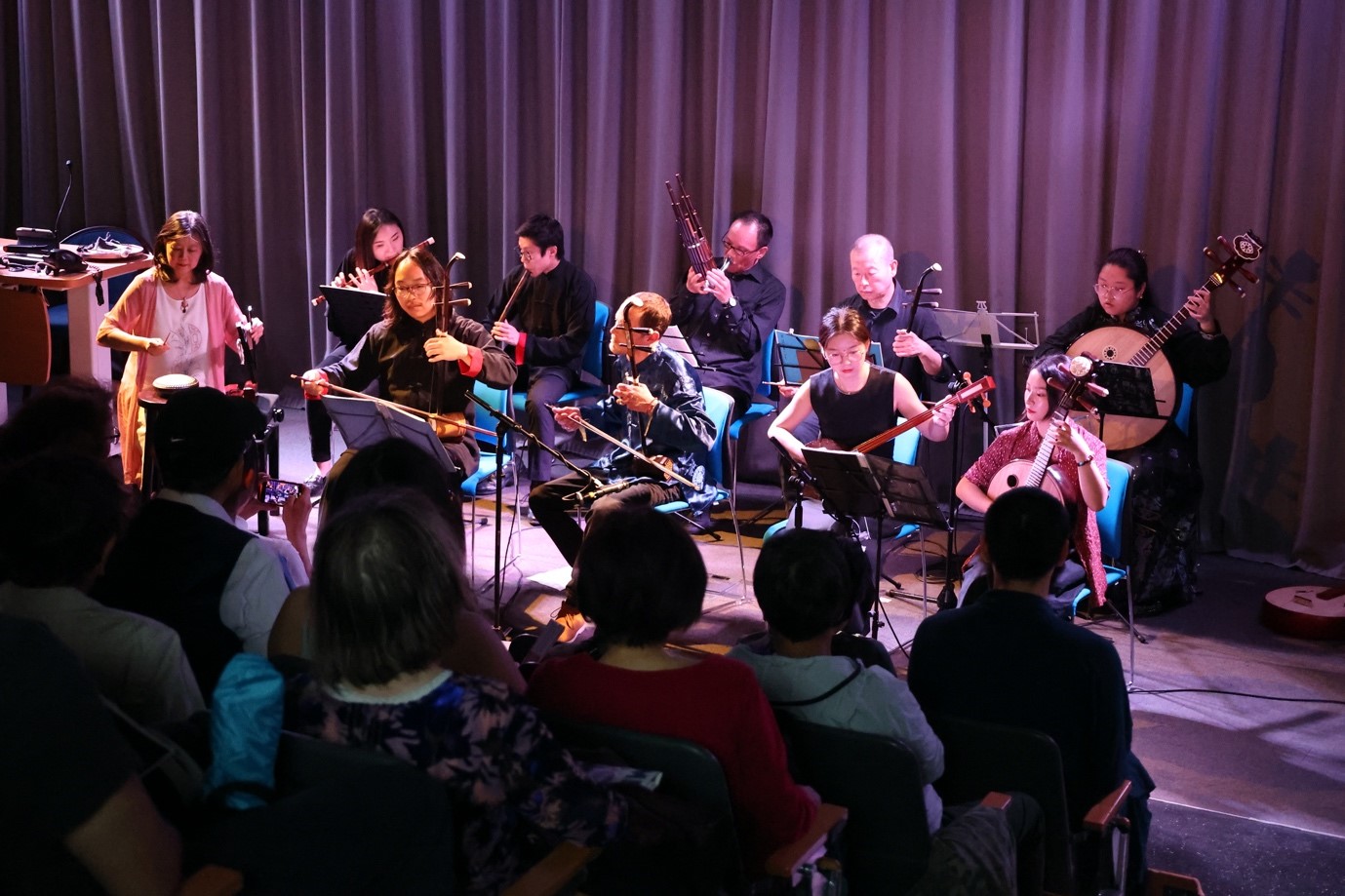

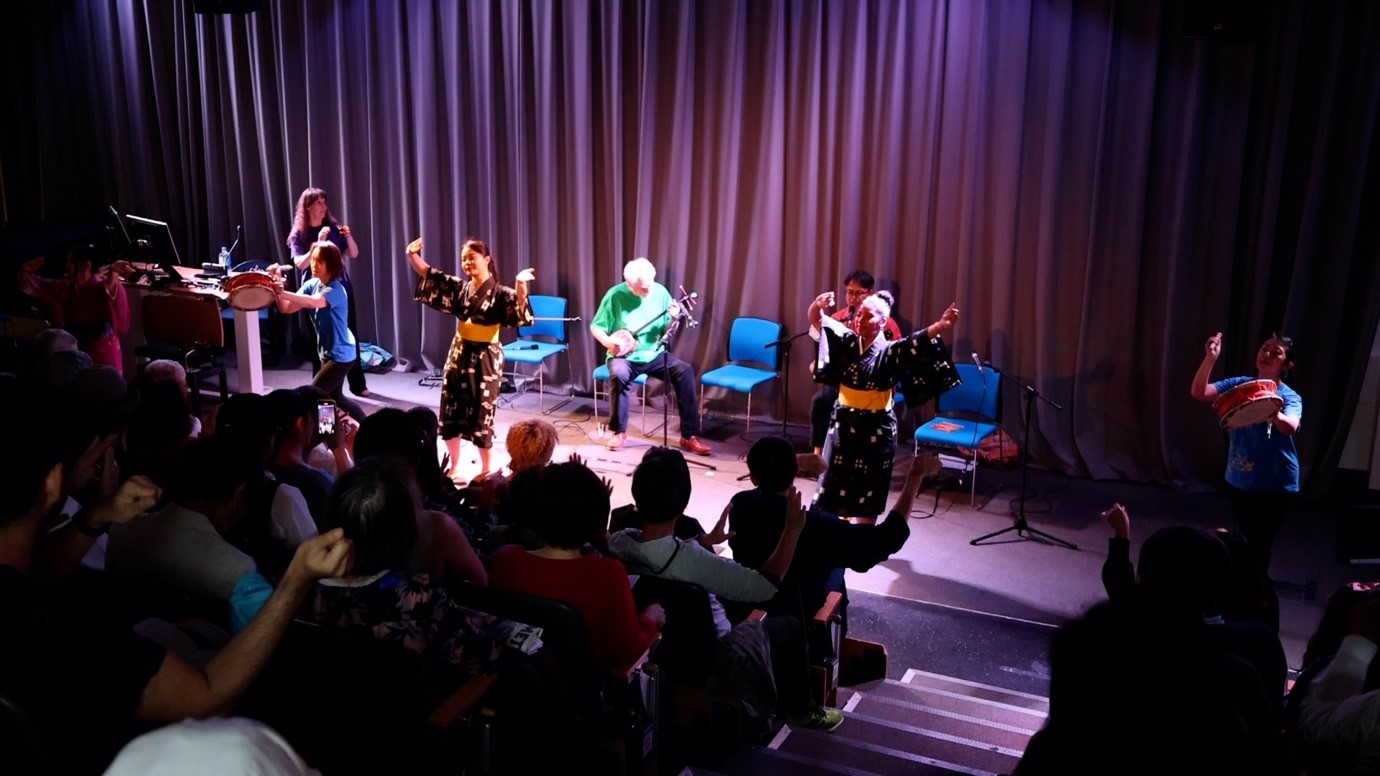


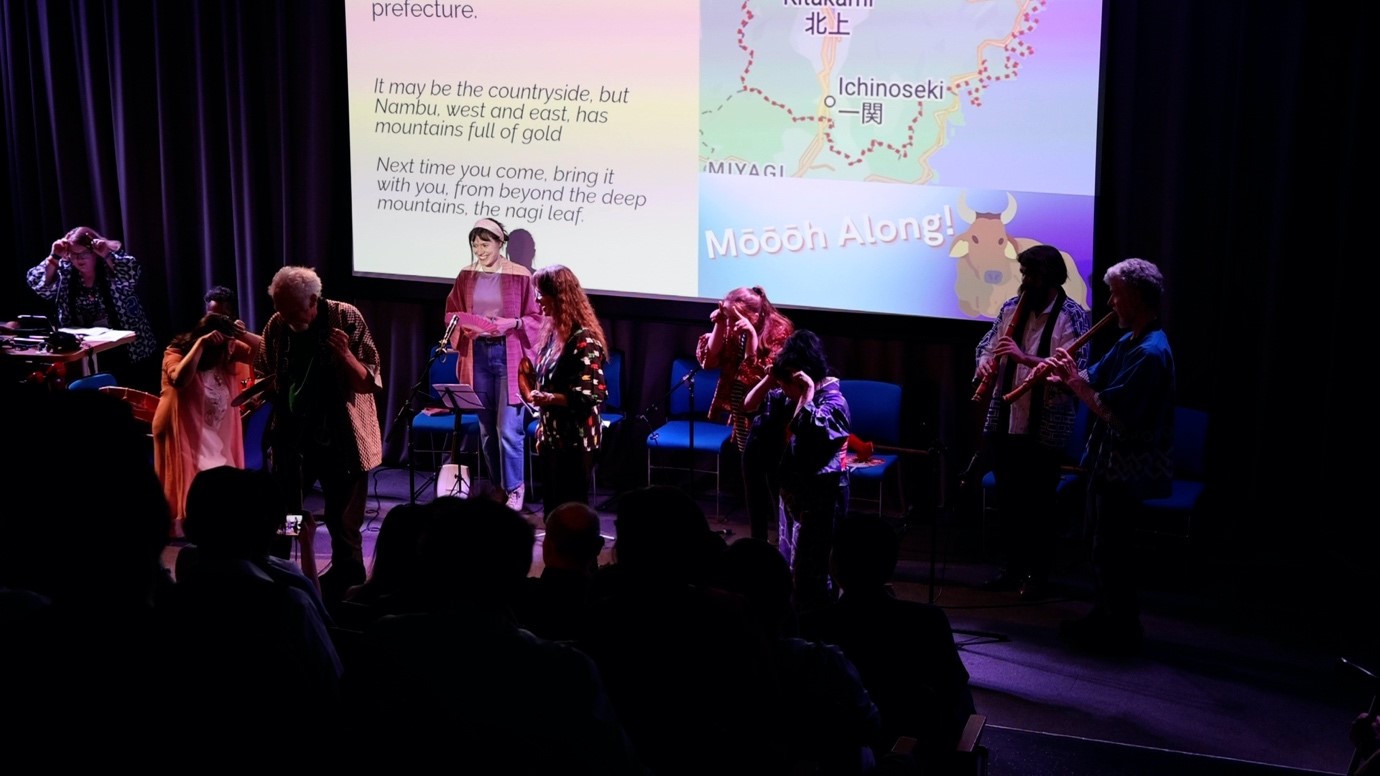
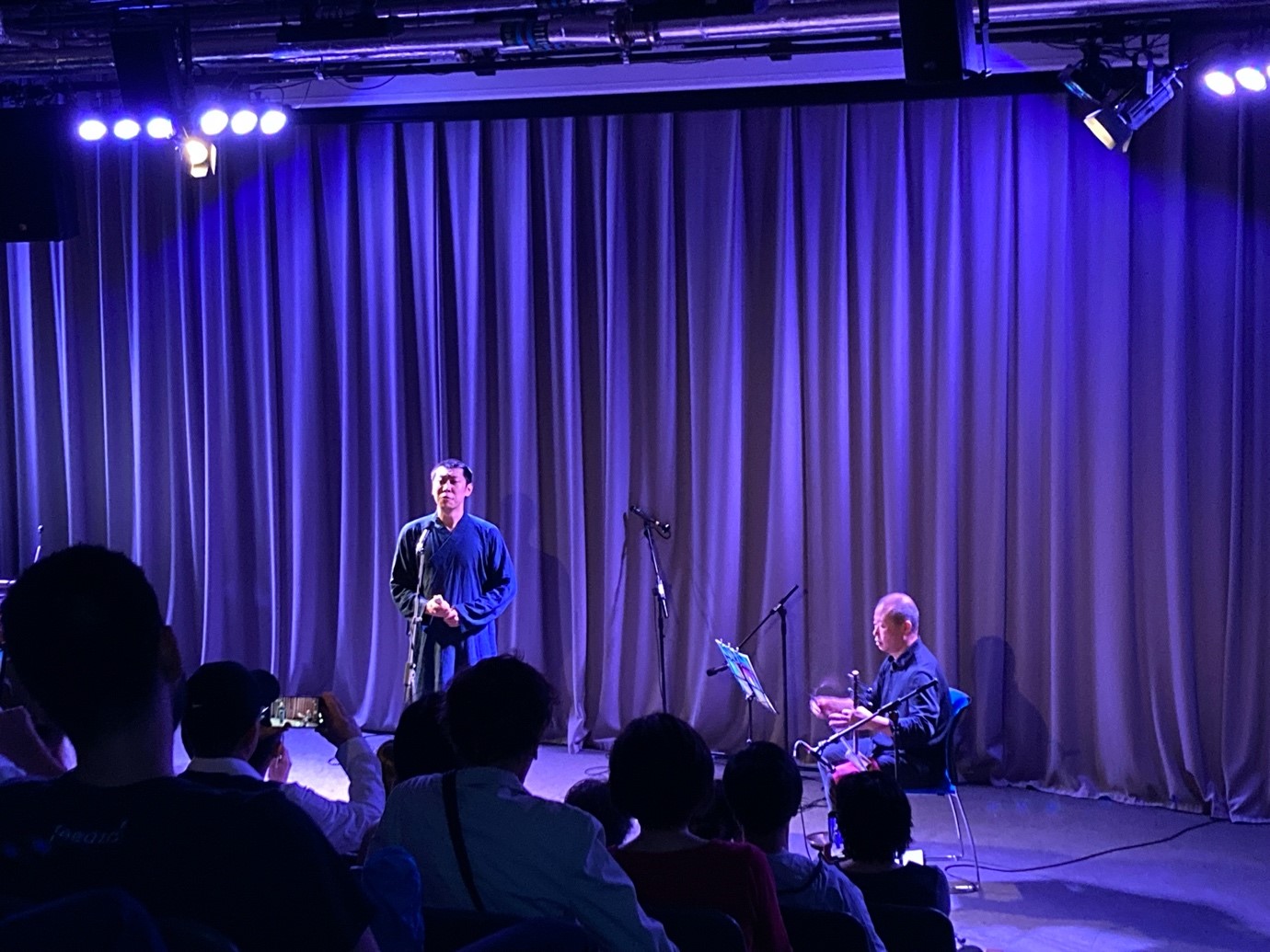
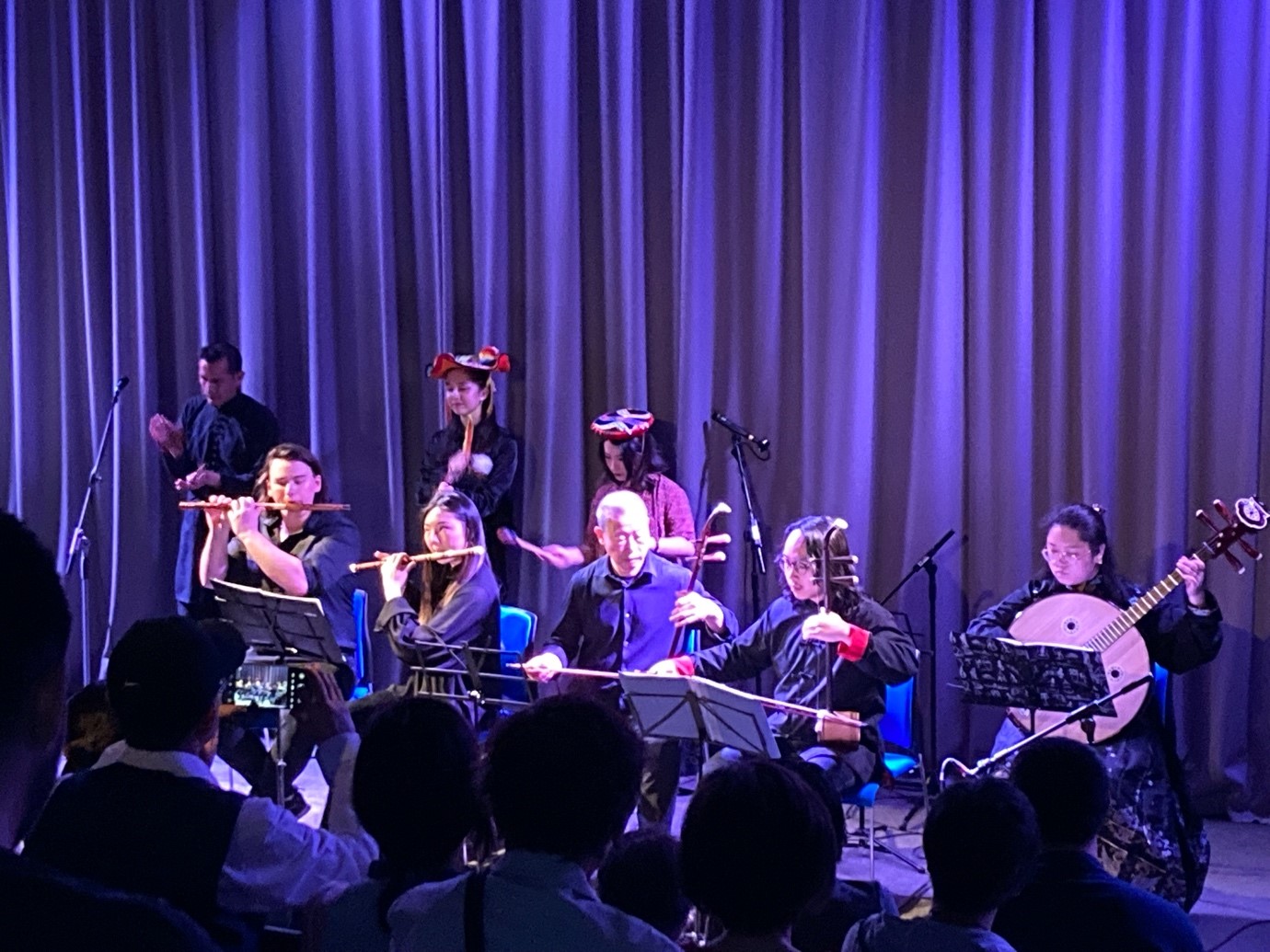
May Activity Report
31 May 2023
Global Japan Office Coordinator
Kazumi Taguchi
I would like to write about an event called “The Radical Aunties Experience” which myself and Ms. Kazuko Hohki, who is the leader of the performance group Frank Chickens, took part in as Ninja Sushi Chefs for a work in progress introduction to Japanese culture, (Our underlying message being that Japanese culture is not complicated but easy to understand).
I put my faith in modern technology to navigate by public transport to the venue, and as a consequence my journey ended up taking a detour and I enjoyed an East London sightseeing bus tour on my way to the destination (Hackney Chinese Community Centre). At the venue, everyone present introduced themselves to each other and found out what activities were featured in the event. Finally, the “Radical Aunties Experience” started.
We were provided a kitchen in the community centre where the event took place, and Kazuko and I changed into Ninja costumes and became Sushi chefs. We rolled many sushis vigorously and enthusiastically and had the chance to talk to many people from many different backgrounds. We enjoyed playing the role of sushi chefs for a day and I hope we livened up the afternoon’s fun.
One of the event organisers a friend of mine, Shii-chan (Dr. Shzr Tan), teaches ethnomusicology at Royal Holloway, University of London, and this event is supported by Royal Holloway. Apart from teaching ethnomusicology, Dr. Tan has been regularly organising seminars focusing on “racial awareness” to increase and promote activities related to equality and people’s rights.
I thought for a first go, the Radical Aunties Experience was very well organised. There was a demonstration of tai chi exercises, a workshop on origami folding, square dance, a healing massage for relaxation, ninja sushi making and an abandoned uncles’ card spot: lots of interesting activities to enjoy.
And we’re now all looking forward to the second Radical Aunties experience?!

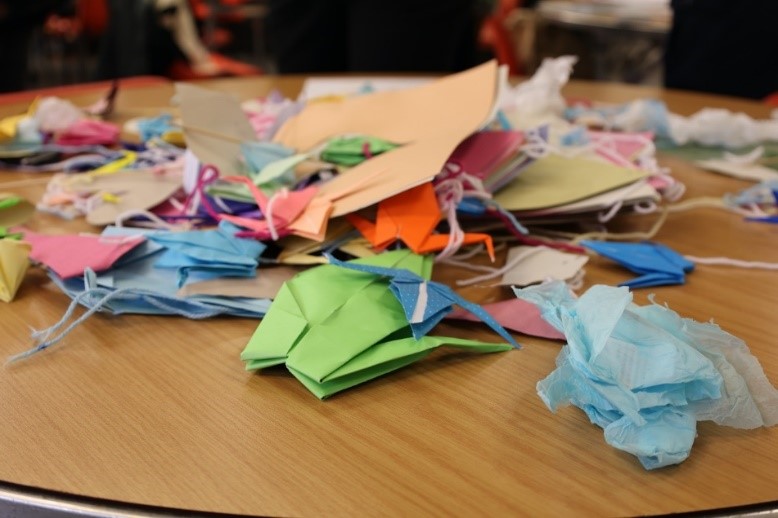


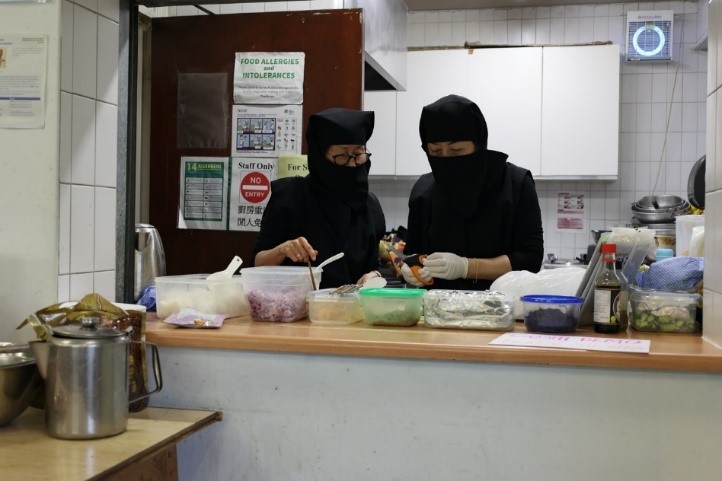
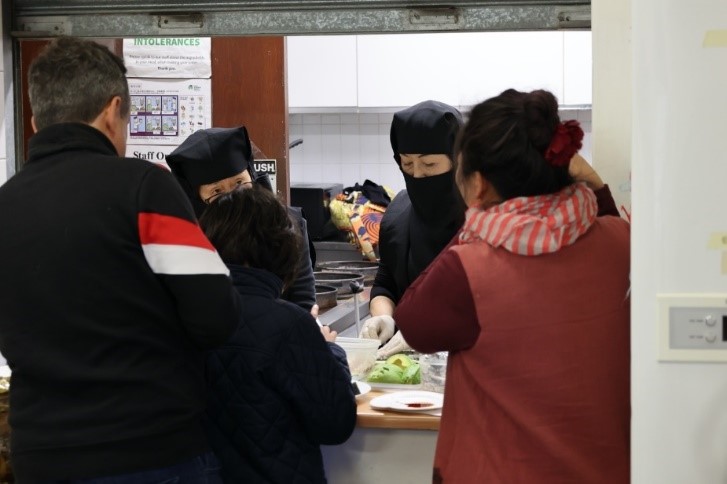




April Activity Report
30 April 2023
Global Japan Office Coordinator
Kazumi Taguchi
For my April London Report, I would like to write about a Balinese Gamelan concert at Brunei Gallery, SOAS.
It has been some time since there was an indoor concert at SOAS as the facilities were closed for a long period due to Covid.
I was aware the Brunei Gallery was now open to the public, but I hadn’t had an opportunity to visit.
I heard that there would be a Gamelan performance, and for the first time in three years I went along to the venue with a friend.
We were treated to a performance by the Bari Gamelan group, Segar Madu (Sea of Honey) led by Nick Gray who trains and leads the group and teaches at the Music department at SOAS, and the projection of a short film based on the retelling of a Balinese tale of transformation and magic.
I was so pleased to be back at an important SOAS concert space where adults and children can listen to global music in a relaxed environment. I felt at ease for a moment, it was wonderful for things to be back as they were before.
Balinese Gamelan is different from Javanese Gamelan. The Balinese Gamelan orchestra consists of bronze metallophones, and musicians play the metallophones with sticks with disk shaped mallets and damp the key whilst playing with the side of hand in a quick tempo. It is a very complicated technique indeed.
The traditional role of this music is to accompany a shadow play, a sacred drama based on stories from ancient Indian epics. The orchestra also performs as a ritual ensemble playing for life-cycle ceremonies, temple festivals, purification rituals and cremations as part of Bali’s rich Hindu heritage.
Balinese Gamelan which involves fast rhythms with intricate melody lines made me feel that the music was telling me a story through my skin and it was a fascinating, mesmerizing experience.
